false000153902900015390292025-03-272025-03-27
UNITED STATES
SECURITIES AND EXCHANGE COMMISSION
WASHINGTON, D.C. 20549
FORM 8-K
CURRENT REPORT
Pursuant to Section 13 or 15(d) of the Securities Exchange Act of 1934
|
Date of Report (Date of earliest event reported): March 27, 2025 |
Clearside Biomedical, Inc.
(Exact name of Registrant as Specified in Its Charter)
|
|
|
|
|
Delaware |
001-37783 |
45-2437375 |
(State or Other Jurisdiction
of Incorporation) |
(Commission File Number) |
(IRS Employer
Identification No.) |
|
|
|
|
|
900 North Point Parkway Suite 200 |
|
Alpharetta, Georgia |
|
30005 |
(Address of Principal Executive Offices) |
|
(Zip Code) |
|
Registrant’s Telephone Number, Including Area Code: (678) 270-3631 |
(Former Name or Former Address, if Changed Since Last Report)
Check the appropriate box below if the Form 8-K filing is intended to simultaneously satisfy the filing obligation of the registrant under any of the following provisions:
☐Written communications pursuant to Rule 425 under the Securities Act (17 CFR 230.425)
☐Soliciting material pursuant to Rule 14a-12 under the Exchange Act (17 CFR 240.14a-12)
☐Pre-commencement communications pursuant to Rule 14d-2(b) under the Exchange Act (17 CFR 240.14d-2(b))
☐Pre-commencement communications pursuant to Rule 13e-4(c) under the Exchange Act (17 CFR 240.13e-4(c))
Securities registered pursuant to Section 12(b) of the Act:
|
|
|
|
|
Title of each class
|
|
Trading
Symbol(s) |
|
Name of each exchange on which registered
|
Common Stock, par value $0.001 per share |
|
CLSD |
|
The Nasdaq Stock Market LLC |
Indicate by check mark whether the registrant is an emerging growth company as defined in Rule 405 of the Securities Act of 1933 (§ 230.405 of this chapter) or Rule 12b-2 of the Securities Exchange Act of 1934 (§ 240.12b-2 of this chapter).
Emerging growth company ☐
If an emerging growth company, indicate by check mark if the registrant has elected not to use the extended transition period for complying with any new or revised financial accounting standards provided pursuant to Section 13(a) of the Exchange Act. ☐
Item 2.02 Results of Operations and Financial Condition.
On March 27, 2025, Clearside Biomedical, Inc. (the “Registrant”) issued a press release announcing its financial results for the quarter and year ended December 31, 2024, as well as information regarding a conference call to discuss these financial results and the Registrant’s recent corporate highlights. A copy of this press release is furnished herewith as Exhibit 99.1 to this Current Report.
In accordance with General Instruction B.2. of Form 8-K, the information in this Item 2.02, and Exhibit 99.1 hereto, shall not be deemed “filed” for purposes of Section 18 of the Securities Exchange Act of 1934, as amended (the “Exchange Act”), or otherwise subject to the liability of that section, nor shall it be deemed incorporated by reference in any of the Registrant’s filings under the Securities Act of 1933, as amended, or the Exchange Act, whether made before or after the date hereof, regardless of any incorporation language in such a filing, except as expressly set forth by specific reference in such a filing.
Item 7.01 Regulation FD Disclosure.
On March 27, 2025, the Registrant updated its corporate presentation for use in meetings with investors, analysts and others. The presentation is available through the Registrant’s website and a copy is attached as Exhibit 99.2 to this Current Report on Form 8-K.
The information in this Item 7.01 of this Current Report on Form 8-K, including Exhibit 99.2, is being furnished pursuant to Item 7.01 and shall not be deemed “filed” for purposes of Section 18 of the Exchange Act or otherwise subject to the liabilities of that section, and it shall not be deemed incorporated by reference in any filing under the Securities Act of 1933, as amended, or under the Exchange Act, whether made before or after the date hereof, except as expressly set forth by specific reference in such filing to this item of this report.
Item 9.01 Financial Statements and Exhibits.
d) Exhibits
SIGNATURES
Pursuant to the requirements of the Securities Exchange Act of 1934, the registrant has duly caused this report to be signed on its behalf by the undersigned hereunto duly authorized.
|
|
|
|
|
|
|
Clearside Biomedical, Inc. |
|
|
|
|
Date: |
March 27,2025 |
By: |
/s/Charles A. Deignan |
|
|
|
Charles A. Deignan
Chief Financial Officer |

Clearside Biomedical Announces Fourth Quarter and Full Year 2024 Financial Results and Provides Corporate Update
- Successful End-of-Phase 2 Meeting with FDA Results in Alignment on Phase 3 Plans for CLS-AX in Wet AMD -
- Asia-Pacific Partner’s New Drug Application for ARCATUS® (XIPERE®) for Uveitic Macular Edema Accepted for Regulatory Review in China -
- Multiple Medical Meeting Presentations Highlight Potential Advantages and Key Differentiators of Suprachoroidal Drug Delivery Utilizing Clearside’s SCS Microinjector® -
- Management to Host Webcast and Conference Call Today at 4:30 P.M. ET -
ALPHARETTA, Ga., March 27, 2025 -- Clearside Biomedical, Inc. (Nasdaq: CLSD), a biopharmaceutical company revolutionizing the delivery of therapies to the back of the eye through the suprachoroidal space (SCS®), today announced financial results for the fourth quarter and year ended December 31, 2024, and provided a corporate update.
“We are redefining the delivery of therapeutics to the retina through the suprachoroidal space with the proven reliability and broad applicability of our innovative SCS Microinjector®,” said George Lasezkay, PharmD, JD, President and Chief Executive Officer. “Over the past six months, we announced positive Phase 2b data, conducted a successful End-of-Phase 2 meeting with the U.S. Food and Drug Administration (FDA), designed the CLS-AX (axitinib injectable suspension) Phase 3 program to maximize commercial potential in wet AMD, and supported several of our SCS Microinjector partners as they advance their suprachoroidal drug candidates into Phase 3 clinical trials.”
“Clearside has developed a differentiated platform of early and later stage SCS assets, has entered into multiple validating SCS collaborations, and has the potential for pipeline expansion opportunities in geographic atrophy, diabetic retinopathy, and diabetic macular edema,” concluded Dr. Lasezkay.
Key Recent Highlights
•Completion of an End-of-Phase 2 meeting with the FDA and alignment on Phase 3 plans for suprachoroidal CLS-AX in wet AMD. The meeting and formal minutes confirmed key elements of the proposed pivotal Phase 3 program, including agreement on the protocol design of two non-inferiority trials, patient population, primary and secondary endpoints, and use of sham injections.
•CLS-AX Phase 3 plans are based on positive results from the ODYSSEY Phase 2b clinical trial that achieved its primary and secondary endpoints, demonstrated extended duration, stable vision and anatomic measures and a well-tolerated safety profile.
•Clearside’s Asia-Pacific partner, Arctic Vision, announced that its New Drug Application (NDA) for ARCATUS® (known as XIPERE® in the U.S.) for the treatment of uveitic macular edema (UME) was formally accepted for review by the Center for Drug Evaluation of China National Medical Products Administration.
•Arctic Vision’s NDAs for ARCATUS were approved by the Therapeutic Goods Administration of Australia and the Health Sciences Authority in Singapore for the treatment of UME.
•Arctic Vision signed a new commercial collaboration with Santen Pharmaceutical Co., Ltd. for commercial rights in China to ARVN001 (ARCATUS) in the treatment of UME and certain other ophthalmic indications under development.
•Clearside’s gene therapy partner, REGENXBIO, in collaboration with AbbVie, announced in January 2025 that they will plan a Phase 3 clinical program for sura-vec (ABBV-RGX-314) using suprachoroidal delivery for the treatment of diabetic retinopathy. Their Phase 2 ALTITUDE® trial is enrolling a cohort of patients with center-involved diabetic macular edema (DME). Their Phase 2 AAVIATE® trial continues enrolling a new cohort to evaluate sura-vec at dose level 4 with a short course of prophylactic steroid eye drops.
•Clearside’s ocular oncology partner, Aura Biosciences, is enrolling patients in its global Phase 3 CoMpass trial evaluating belzupacap sarotalocan (bel-sar) for the first-line treatment of adult patients with small choroidal melanoma or indeterminate lesions.
•Clearside’s partner, BioCryst Pharmaceuticals, highlighted plans to initiate clinical testing in 2025 of avoralstat, its plasma kallikrein inhibitor, for the potential treatment of DME.
•Multiple medical meeting presentations were delivered on transforming retinal disease treatments using suprachoroidal delivery, including Hawaiian Eye & Retina 2025, 3rd Annual Ophthalmic Drug Delivery Summit, Angiogenesis, Exudation, and
Degeneration 2025, Macula Society 48th Annual Meeting, Asia-Pacific Vitreo-Retina Society (APVRS), and the Academy of Ophthalmology (AAO).
•The Royal College of Ophthalmologists, Eye and Nature.com, published a summary of critical insights into drug development and regulatory processes based on a presentation at the prestigious annual Edridge Green Lecture by Clearside’s Chief Medical Officer and Executive Vice President, Head of Research and Development, Dr. Victor Chong. The article provides a comprehensive overview of the intricate processes involved in clinical trial design and regulatory pathways for drug development, with a special focus on retinal diseases.
•Tony Gibney was appointed Chair of Clearside’s Board of Directors, effective November 1, 2024, succeeding Clay Thorp, who continues serving as a member of the Board. Mr. Gibney joined Clearside’s Board as an independent director in April 2024 and is an experienced biotechnology executive and former investment banker, most recently serving as Executive Vice President, Chief Business & Strategy Officer, of Iveric Bio, Inc. until the company’s acquisition by Astellas Pharma Inc. in July 2023.
Fourth Quarter 2024 Financial Results
•License and other revenue for the fourth quarter of 2024 was $0.3 million, compared to $6.3 million for the fourth quarter of 2023. The decrease was primarily attributable to the receipt of license fees and milestone payments from partners in the fourth quarter of 2023.
•Research and development (R&D) expenses for the fourth quarter of 2024 were $4.2 million, compared to $6.3 million for the fourth quarter of 2023. The decrease was primarily due to lower clinical trial costs following completion of the ODYSSEY Phase 2b trial.
•General and administrative (G&A) expenses for the fourth quarter of 2024 were $3.1 million, compared to $2.9 million for the fourth quarter of 2023. The increase was primarily due to higher patent-related expenses and consulting fees.
•Net loss for the fourth quarter of 2024 was $7.3 million, or $0.10 per share of common stock, compared to net loss of $4.8 million, or $0.08 per share of common stock, for the fourth quarter of 2023. The increase in net loss was primarily attributable to the receipt of license fees and milestone payments from partners in the fourth quarter of 2023.
•As of December 31, 2024, Clearside’s cash and cash equivalents totaled $20.0 million. The Company believes it will have sufficient resources to fund its planned operations into the fourth quarter of 2025.
Full Year 2024 Financial Results
•License and other revenue for the year ended December 31, 2024 was $1.7 million, compared to $8.2 million for the year ended December 31, 2023. The $6.6 million decrease was primarily attributable to the receipt of license fees and milestone payments from partners in the fourth quarter of 2023.
•R&D expenses for the year ended December 31, 2024 were $18.6 million, compared to $20.8 million for the year ended December 31, 2023. The decrease was primarily due to lower clinical trial costs following completion of the ODYSSEY Phase 2b trial.
•G&A expenses for the year ended December 31, 2024 were $11.8 million, compared to $11.9 million for the year ended December 31, 2023.
•Net loss for the year ended December 31, 2024 was $34.4 million, or $0.47 per share of common stock, compared to net loss of $32.5 million, or $0.53 per share of common stock, for the year ended December 31, 2023.
Conference Call & Webcast Details
Clearside’s management will host a webcast and conference call today at 4:30 p.m. Eastern Time to discuss the financial results and provide a corporate update. The live and archived webcast may be accessed on the Clearside website under the Investors section: Events and Presentations. The live call can be accessed by dialing 888-506-0062 (domestic) or 973-528-0011 (international) and entering conference code: 733956. The Company suggests participants join 15 minutes in advance of the event.
About Clearside Biomedical, Inc.
Clearside Biomedical, Inc. is a biopharmaceutical company revolutionizing the delivery of therapies to the back of the eye through the suprachoroidal space (SCS®) to improve patient outcomes. Clearside’s SCS injection platform, utilizing the Company’s patented SCS Microinjector®, enables an in-office, repeatable, non-surgical procedure for the targeted and compartmentalized delivery of a wide variety of therapies to the macula, retina, or choroid to potentially preserve and improve vision in patients with sight-threatening eye diseases. Clearside is developing its own pipeline of small molecule product candidates for administration via its SCS Microinjector. The Company’s lead program, CLS-AX (axitinib injectable suspension), is in development for the treatment of neovascular age-related macular degeneration (wet AMD). Planning for a Phase 3 program is underway. In addition, Clearside is evaluating various small molecules for the potential long-acting treatment of geographic atrophy (GA). Clearside developed and gained approval for its first product, XIPERE® (triamcinolone acetonide injectable suspension) for suprachoroidal use, which is available in the U.S. through a commercial partner. Clearside also strategically partners its SCS injection platform with companies
utilizing other ophthalmic therapeutic innovations. For more information, please visit clearsidebio.com or follow us on LinkedIn and X.
Cautionary Note Regarding Forward-Looking Statements
Any statements contained in this press release that do not describe historical facts may constitute forward-looking statements as that term is defined in the Private Securities Litigation Reform Act of 1995. These statements may be identified by words such as “believe”, “expect”, “may”, “plan”, “potential”, “will”, and similar expressions, and are based on Clearside’s current beliefs and expectations. These forward-looking statements include statements regarding the clinical development of CLS-AX, including the planned Phase 3 trial design, CLS-AX’s potential impact on the wet AMD market, the potential benefits of CLS-AX, Clearside’s suprachoroidal delivery technology and Clearside’s SCS Microinjector®, pipeline expansion opportunities, and Clearside’s ability to fund its operations into the fourth quarter of 2025. These statements involve risks and uncertainties that could cause actual results to differ materially from those reflected in such statements. Risks and uncertainties that may cause actual results to differ materially include uncertainties inherent in the conduct of clinical trials, Clearside’s reliance on third parties over which it may not always have full control, Clearside's ability to raise additional capital, and other risks and uncertainties that are described in Clearside’s Annual Report on Form 10-K for the year ended December 31, 2024, filed with the U.S. Securities and Exchange Commission (SEC) on March 27, 2025 and Clearside’s other Periodic Reports filed with the SEC. Any forward-looking statements speak only as of the date of this press release and are based on information available to Clearside as of the date of this release, and Clearside assumes no obligation to, and does not intend to, update any forward-looking statements, whether as a result of new information, future events or otherwise.
*Reference
•XIPERE® (triamcinolone acetonide injectable suspension) for suprachoroidal use is being commercialized by Bausch + Lomb who has the exclusive license for the commercialization and development of XIPERE in the United States and Canada. Arctic Vision has the exclusive license for the commercialization and development of XIPERE, in Greater China, South Korea, Australia, New Zealand, India and the ASEAN Countries. XIPERE is approved by the U.S. Food and Drug Administration and is commercially available in the U.S. A link to the full prescribing information is available at https://www.xipere.com/hcp/#isi.
Investor and Media Contacts:
Jenny Kobin
Remy Bernarda
ir@clearsidebio.com
-Financial Tables Follow-
CLEARSIDE BIOMEDICAL, INC.
Selected Financial Data
(in thousands, except share and per share data)
(unaudited)
|
|
|
|
|
|
|
|
|
|
|
|
|
|
|
|
|
Statements of Operations Data |
|
Three Months Ended December 31, |
|
|
Year Ended December 31, |
|
|
|
2024 |
|
|
2023 |
|
|
2024 |
|
|
2023 |
|
License and other revenue |
|
$ |
306 |
|
|
$ |
6,345 |
|
|
$ |
1,664 |
|
|
$ |
8,226 |
|
Operating expenses: |
|
|
|
|
|
|
|
|
|
|
|
|
|
|
|
|
Cost of goods sold |
|
|
149 |
|
|
|
— |
|
|
|
149 |
|
|
|
355 |
|
Research and development |
|
|
4,244 |
|
|
|
6,313 |
|
|
|
18,590 |
|
|
|
20,846 |
|
General and administrative |
|
|
3,062 |
|
|
|
2,947 |
|
|
|
11,807 |
|
|
|
11,869 |
|
Total operating expenses |
|
|
7,455 |
|
|
|
9,260 |
|
|
|
30,546 |
|
|
|
33,070 |
|
Loss from operations |
|
|
(7,149 |
) |
|
|
(2,915 |
) |
|
|
(28,882 |
) |
|
|
(24,844 |
) |
Interest income |
|
|
358 |
|
|
|
360 |
|
|
|
1,462 |
|
|
|
1,719 |
|
Other income, net |
|
|
2,064 |
|
|
|
— |
|
|
|
2,847 |
|
|
|
— |
|
Non-cash interest expense on liability related to
the sales of future royalties |
|
|
(2,579 |
) |
|
|
(2,277 |
) |
|
|
(9,779 |
) |
|
|
(9,360 |
) |
Net loss |
|
$ |
(7,306 |
) |
|
$ |
(4,832 |
) |
|
$ |
(34,352 |
) |
|
$ |
(32,485 |
) |
Net loss per share of common stock — basic
and diluted |
|
$ |
(0.10 |
) |
|
$ |
(0.08 |
) |
|
$ |
(0.47 |
) |
|
$ |
(0.53 |
) |
Weighted average shares outstanding — basic
and diluted |
|
|
75,850,759 |
|
|
|
62,404,329 |
|
|
|
73,803,348 |
|
|
|
61,806,959 |
|
|
|
|
|
|
|
|
|
Balance Sheet Data |
December 31, |
|
|
December 31, |
|
|
2024 |
|
|
2023 |
|
|
|
|
|
|
|
|
|
Cash and cash equivalents |
$ |
20,020 |
|
|
$ |
28,920 |
|
Total assets |
|
25,126 |
|
|
|
34,018 |
|
Liabilities related to the sales of future royalties, net |
|
51,767 |
|
|
|
41,988 |
|
Warrant liabilities |
|
6,692 |
|
|
|
— |
|
Total liabilities |
|
63,981 |
|
|
|
49,930 |
|
Total stockholders’ deficit |
|
(38,855 |
) |
|
|
(15,912 |
) |
Source: Clearside Biomedical, Inc.
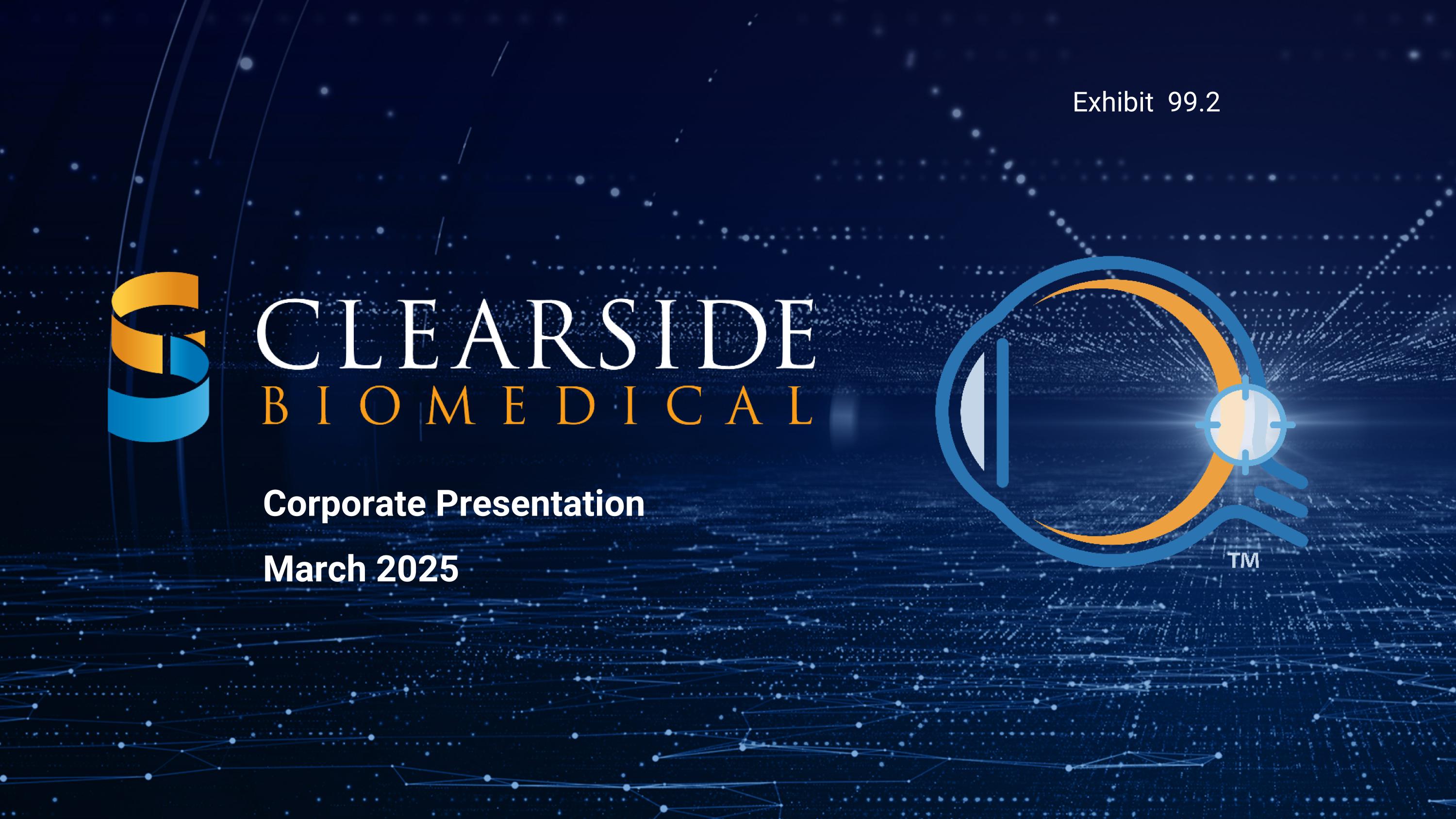
Corporate Presentation March 2025 Exhibit 99.2
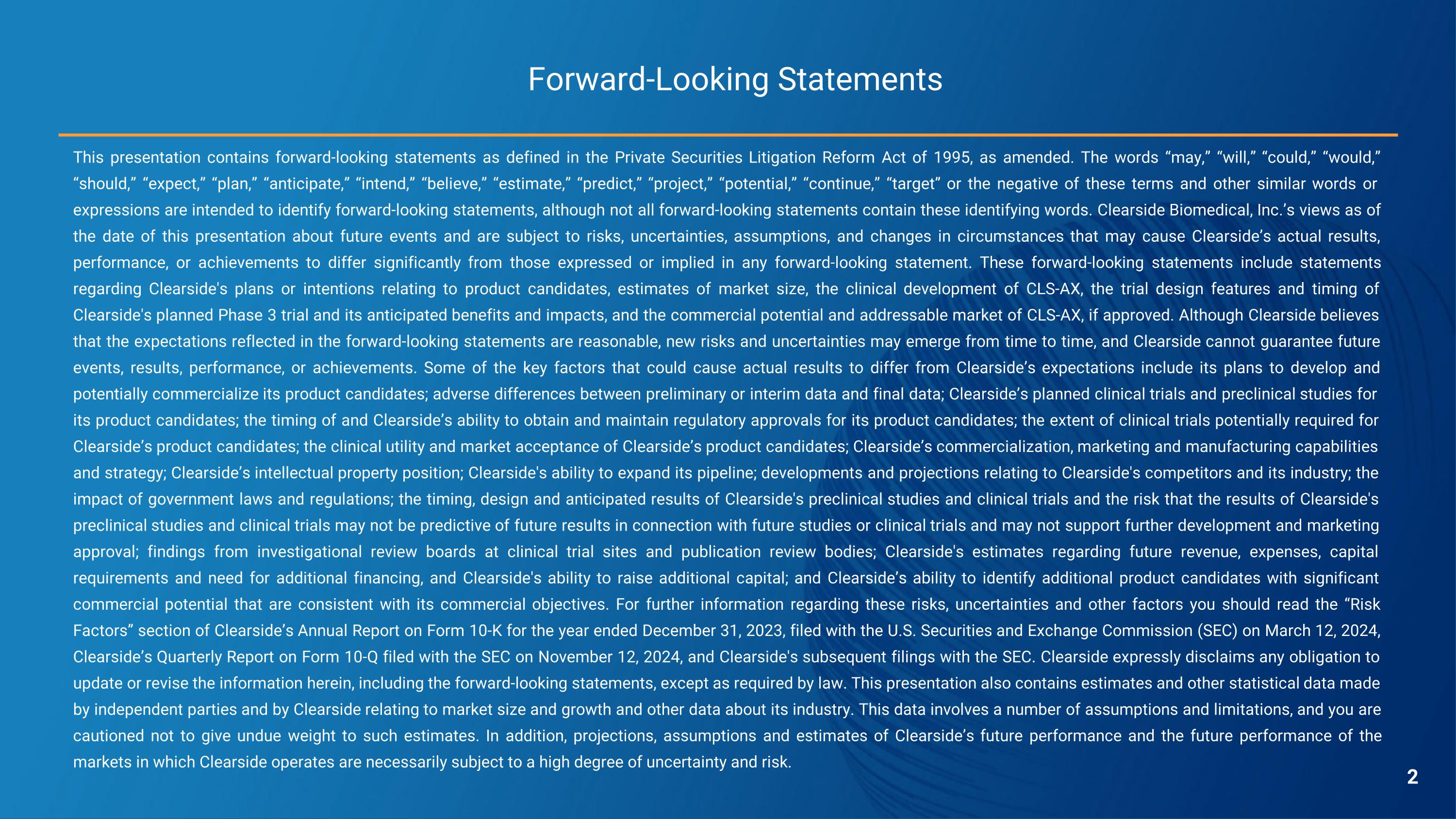
Forward-Looking Statements This presentation contains forward-looking statements as defined in the Private Securities Litigation Reform Act of 1995, as amended. The words “may,” “will,” “could,” “would,” “should,” “expect,” “plan,” “anticipate,” “intend,” “believe,” “estimate,” “predict,” “project,” “potential,” “continue,” “target” or the negative of these terms and other similar words or expressions are intended to identify forward-looking statements, although not all forward-looking statements contain these identifying words. Clearside Biomedical, Inc.’s views as of the date of this presentation about future events and are subject to risks, uncertainties, assumptions, and changes in circumstances that may cause Clearside’s actual results, performance, or achievements to differ significantly from those expressed or implied in any forward-looking statement. These forward-looking statements include statements regarding Clearside's plans or intentions relating to product candidates, estimates of market size, the clinical development of CLS-AX, the trial design features and timing of Clearside's planned Phase 3 trial and its anticipated benefits and impacts, and the commercial potential and addressable market of CLS-AX, if approved. Although Clearside believes that the expectations reflected in the forward-looking statements are reasonable, new risks and uncertainties may emerge from time to time, and Clearside cannot guarantee future events, results, performance, or achievements. Some of the key factors that could cause actual results to differ from Clearside’s expectations include its plans to develop and potentially commercialize its product candidates; adverse differences between preliminary or interim data and final data; Clearside’s planned clinical trials and preclinical studies for its product candidates; the timing of and Clearside’s ability to obtain and maintain regulatory approvals for its product candidates; the extent of clinical trials potentially required for Clearside’s product candidates; the clinical utility and market acceptance of Clearside’s product candidates; Clearside’s commercialization, marketing and manufacturing capabilities and strategy; Clearside’s intellectual property position; Clearside's ability to expand its pipeline; developments and projections relating to Clearside's competitors and its industry; the impact of government laws and regulations; the timing, design and anticipated results of Clearside's preclinical studies and clinical trials and the risk that the results of Clearside's preclinical studies and clinical trials may not be predictive of future results in connection with future studies or clinical trials and may not support further development and marketing approval; findings from investigational review boards at clinical trial sites and publication review bodies; Clearside's estimates regarding future revenue, expenses, capital requirements and need for additional financing, and Clearside's ability to raise additional capital; and Clearside’s ability to identify additional product candidates with significant commercial potential that are consistent with its commercial objectives. For further information regarding these risks, uncertainties and other factors you should read the “Risk Factors” section of Clearside’s Annual Report on Form 10-K for the year ended December 31, 2023, filed with the U.S. Securities and Exchange Commission (SEC) on March 12, 2024, Clearside’s Quarterly Report on Form 10-Q filed with the SEC on November 12, 2024, and Clearside's subsequent filings with the SEC. Clearside expressly disclaims any obligation to update or revise the information herein, including the forward-looking statements, except as required by law. This presentation also contains estimates and other statistical data made by independent parties and by Clearside relating to market size and growth and other data about its industry. This data involves a number of assumptions and limitations, and you are cautioned not to give undue weight to such estimates. In addition, projections, assumptions and estimates of Clearside’s future performance and the future performance of the markets in which Clearside operates are necessarily subject to a high degree of uncertainty and risk. 2
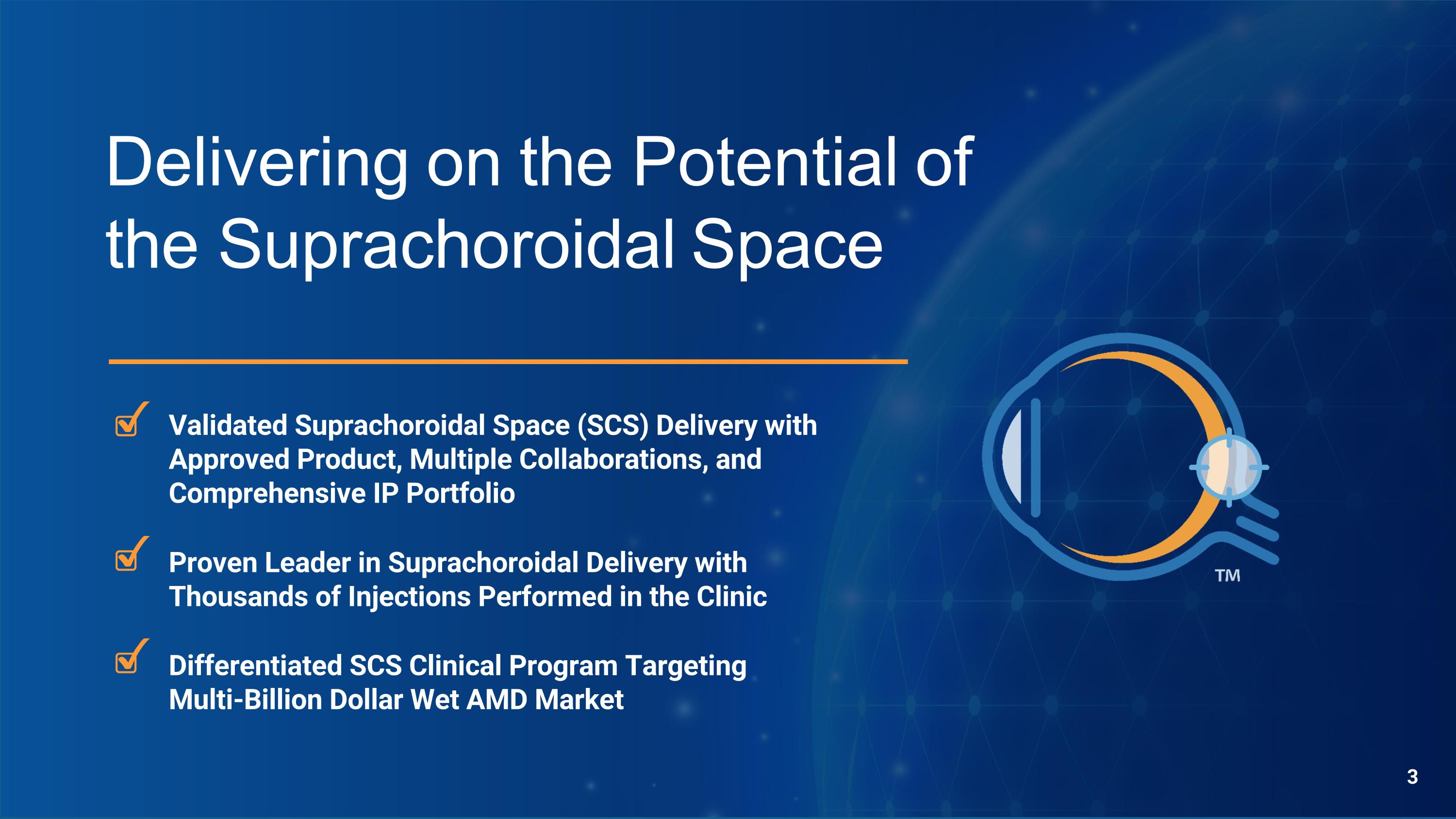
Delivering on the Potential of the Suprachoroidal Space Proven Leader in Suprachoroidal Delivery with Thousands of Injections Performed in the Clinic Validated Suprachoroidal Space (SCS) Delivery with Approved Product, Multiple Collaborations, and Comprehensive IP Portfolio Differentiated SCS Clinical Program Targeting Multi-Billion Dollar Wet AMD Market 3

Clearside Suprachoroidal Product Development Pipeline Targeting Global Markets 1XIPERE® (triamcinolone acetonide injectable suspension), for suprachoroidal use has received U.S. FDA Approval and is being commercialized by Bausch + Lomb. 2In licensed territories, Arctic Vision is responsible for clinical development of ARCATUS™ (triamcinolone acetonide injectable suspension), also known as ARVN001, and known as XIPERE® in the U.S. *Phase 3 plans are in process. Clearside Research and Clinical Development Programs THERAPEUTIC MECHANISM INDICATION PRE-CLINICAL PHASE 1 PHASE 2 PHASE 3 APPROVAL PARTNER CLS-AX (axitinib) Tyrosine Kinase Inhibitor Wet AMD* Undisclosed Improve choroidal perfusion Geographic Atrophy (GA) Undisclosed Modulate pro-inflammatory cells Geographic Atrophy (GA) Commercial Asset: XIPERE® (triamcinolone acetonide injectable suspension) for suprachoroidal use THERAPEUTIC LOCATION INDICATION PRE-CLINICAL PHASE 1 PHASE 2 PHASE 3 APPROVAL PARTNER XIPERE® United States Uveitic Macular Edema1 XIPERE® / ARCATUS™ Australia and Singapore Uveitic Macular Edema2 XIPERE® / ARCATUS™ China Uveitic Macular Edema2 XIPERE® / ARCATUS™ Asia Pacific ex-Japan Diabetic Macular Edema2 UME FDA End-of-Phase 2 Meeting Completed NDA Under Review
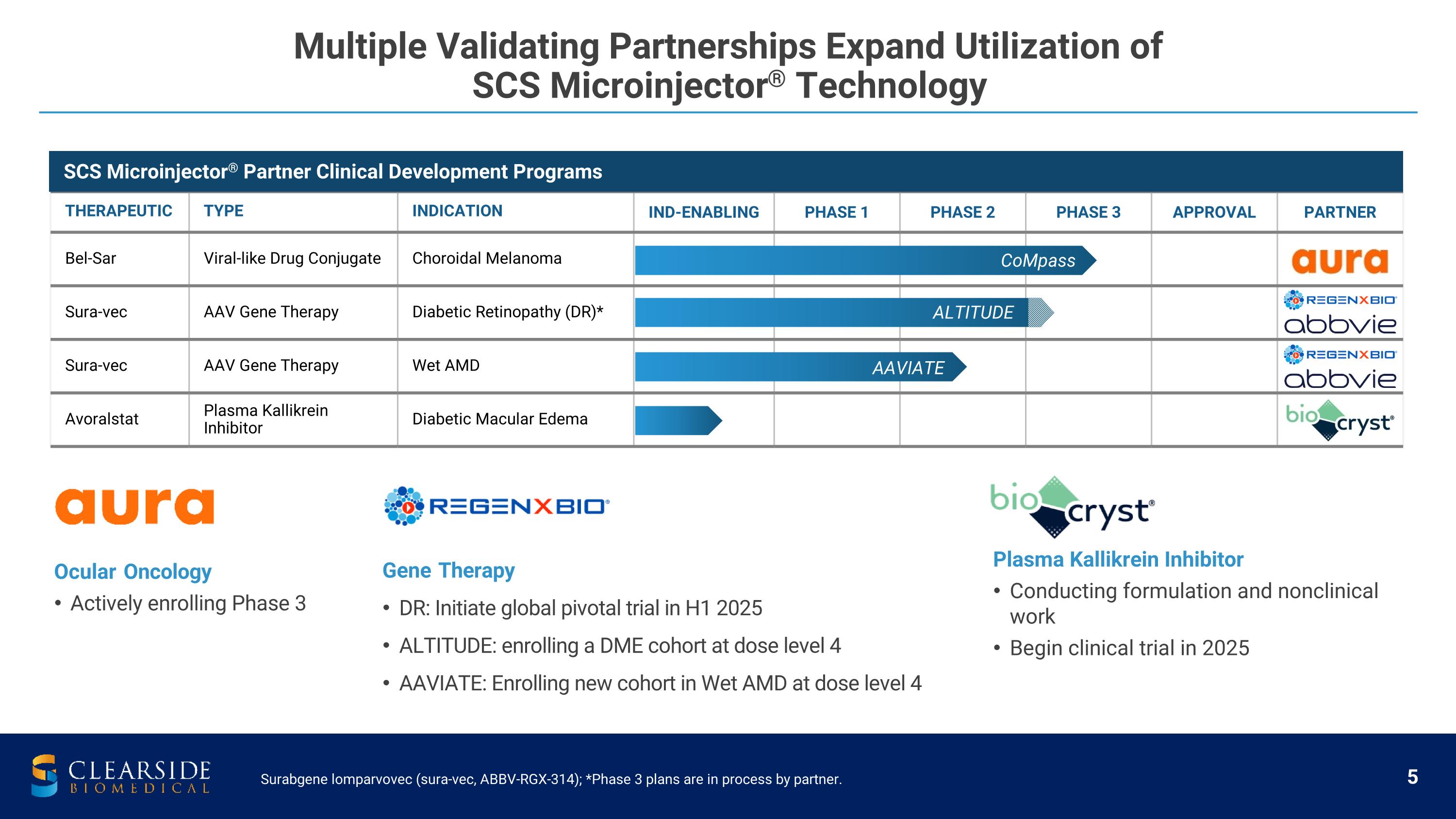
Multiple Validating Partnerships Expand Utilization of �SCS Microinjector® Technology THERAPEUTIC TYPE INDICATION IND-ENABLING PHASE 1 PHASE 2 PHASE 3 APPROVAL PARTNER Bel-Sar Viral-like Drug Conjugate Choroidal Melanoma Sura-vec AAV Gene Therapy Diabetic Retinopathy (DR)* Sura-vec AAV Gene Therapy Wet AMD Avoralstat Plasma Kallikrein Inhibitor Diabetic Macular Edema SCS Microinjector® Partner Clinical Development Programs ALTITUDE AAVIATE CoMpass ALTITUDE Gene Therapy DR: Initiate global pivotal trial in H1 2025 ALTITUDE: enrolling a DME cohort at dose level 4 AAVIATE: Enrolling new cohort in Wet AMD at dose level 4 Ocular Oncology Actively enrolling Phase 3 Plasma Kallikrein Inhibitor Conducting formulation and nonclinical work Begin clinical trial in 2025 Surabgene lomparvovec (sura-vec, ABBV-RGX-314); *Phase 3 plans are in process by partner.
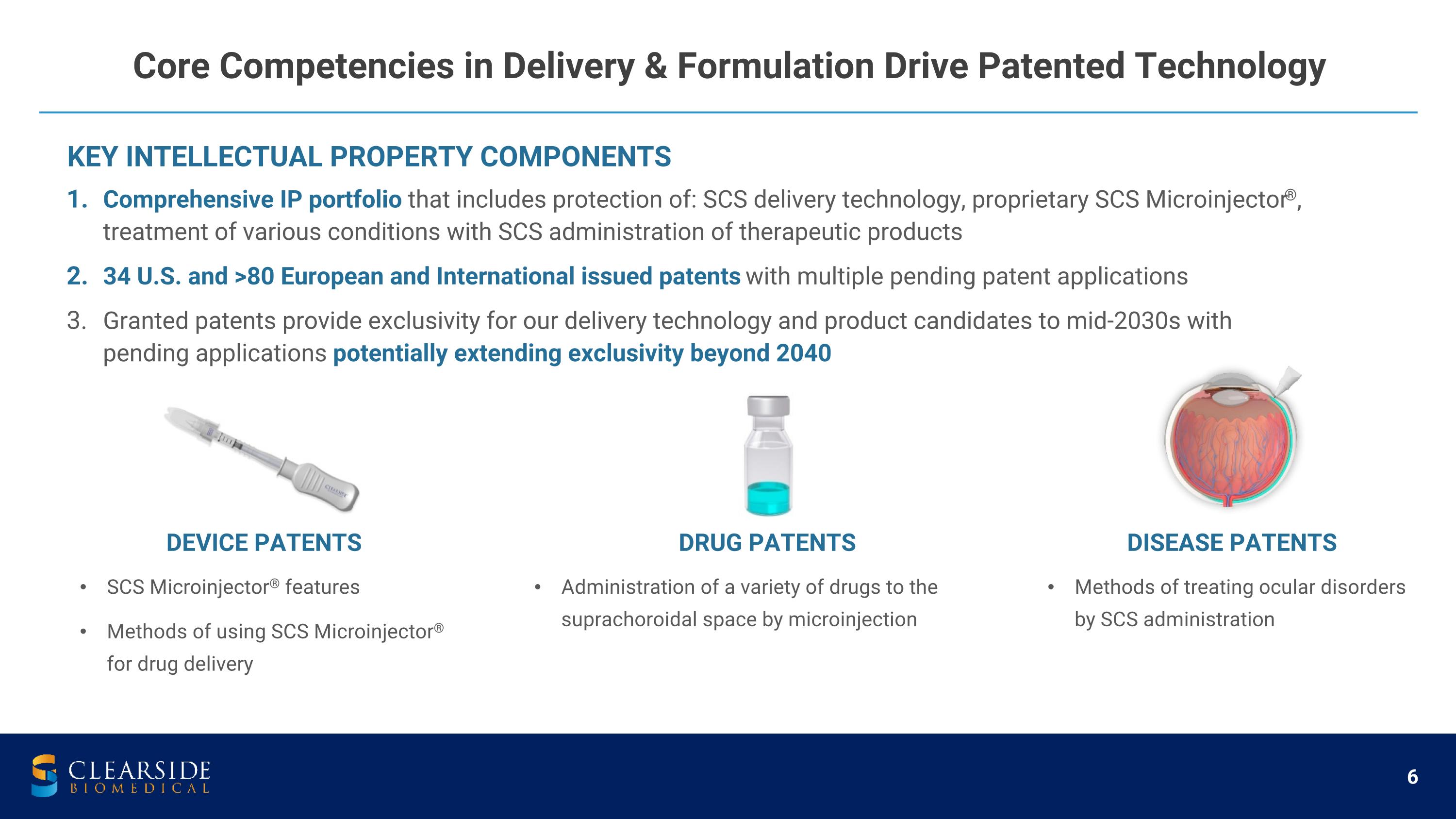
Core Competencies in Delivery & Formulation Drive Patented Technology DRUG PATENTS Administration of a variety of drugs to the suprachoroidal space by microinjection DISEASE PATENTS Methods of treating ocular disorders by SCS administration KEY INTELLECTUAL PROPERTY COMPONENTS Comprehensive IP portfolio that includes protection of: SCS delivery technology, proprietary SCS Microinjector®, treatment of various conditions with SCS administration of therapeutic products 34 U.S. and >80 European and International issued patents with multiple pending patent applications Granted patents provide exclusivity for our delivery technology and product candidates to mid-2030s with pending applications potentially extending exclusivity beyond 2040 DEVICE PATENTS SCS Microinjector® features Methods of using SCS Microinjector® for drug delivery
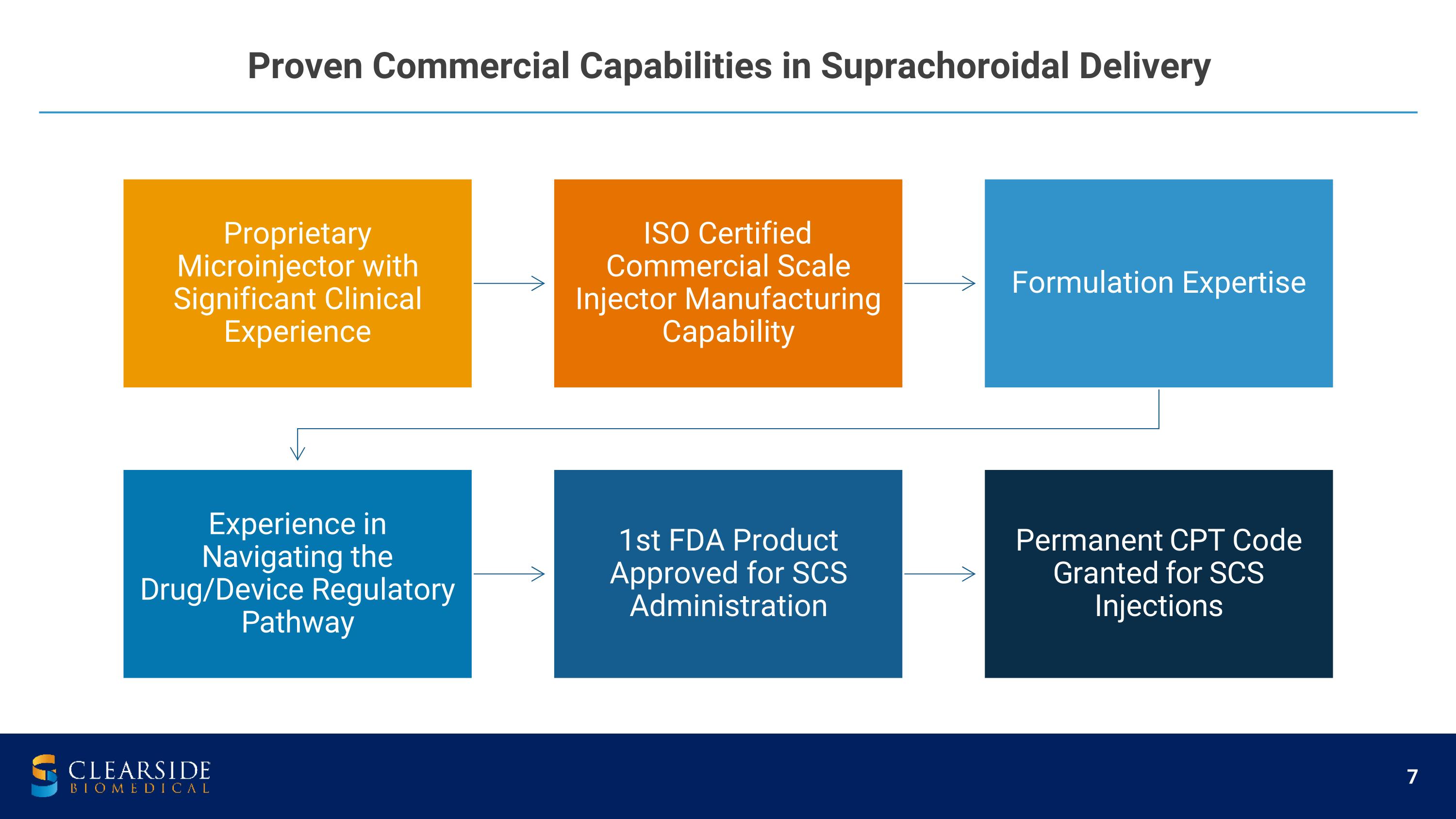
Proven Commercial Capabilities in Suprachoroidal Delivery Proprietary Microinjector with Significant Clinical Experience ISO Certified Commercial Scale Injector Manufacturing Capability Formulation Expertise Experience in Navigating the Drug/Device Regulatory Pathway 1st FDA Product Approved for SCS Administration Permanent CPT Code Granted for SCS Injections
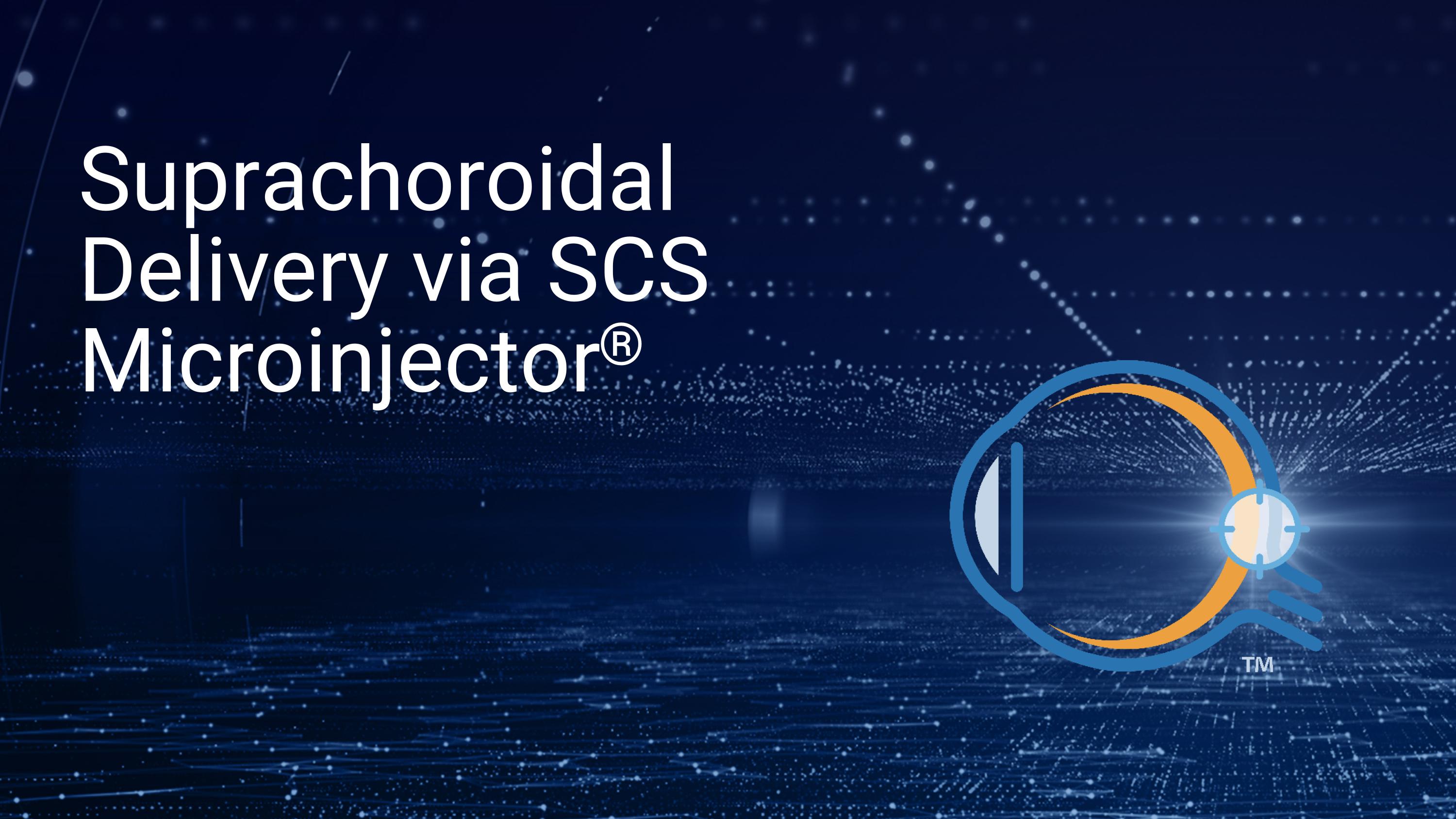
Suprachoroidal Delivery via SCS Microinjector®
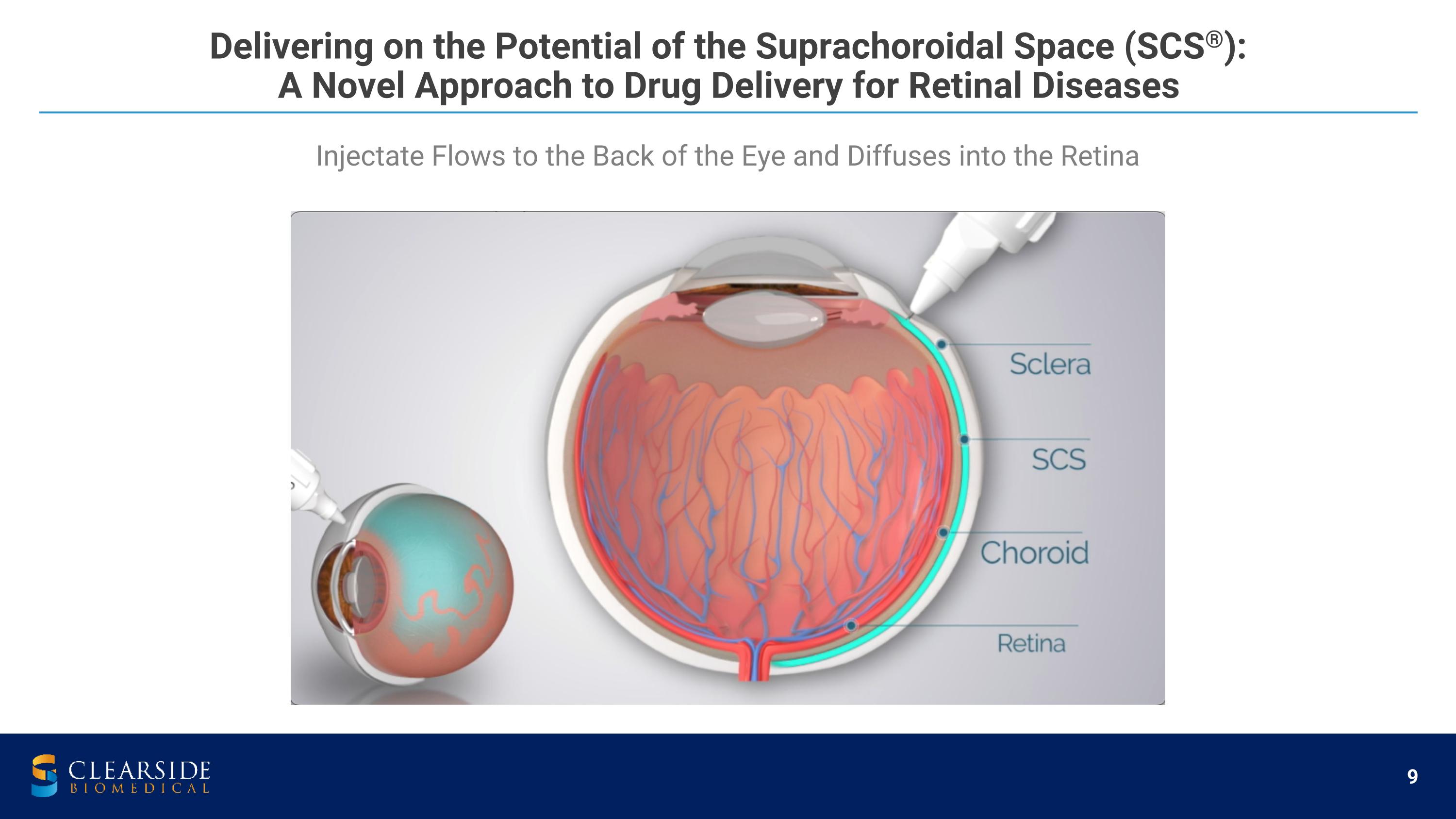
Delivering on the Potential of the Suprachoroidal Space (SCS®): A Novel Approach to Drug Delivery for Retinal Diseases Injectate Flows to the Back of the Eye and Diffuses into the Retina
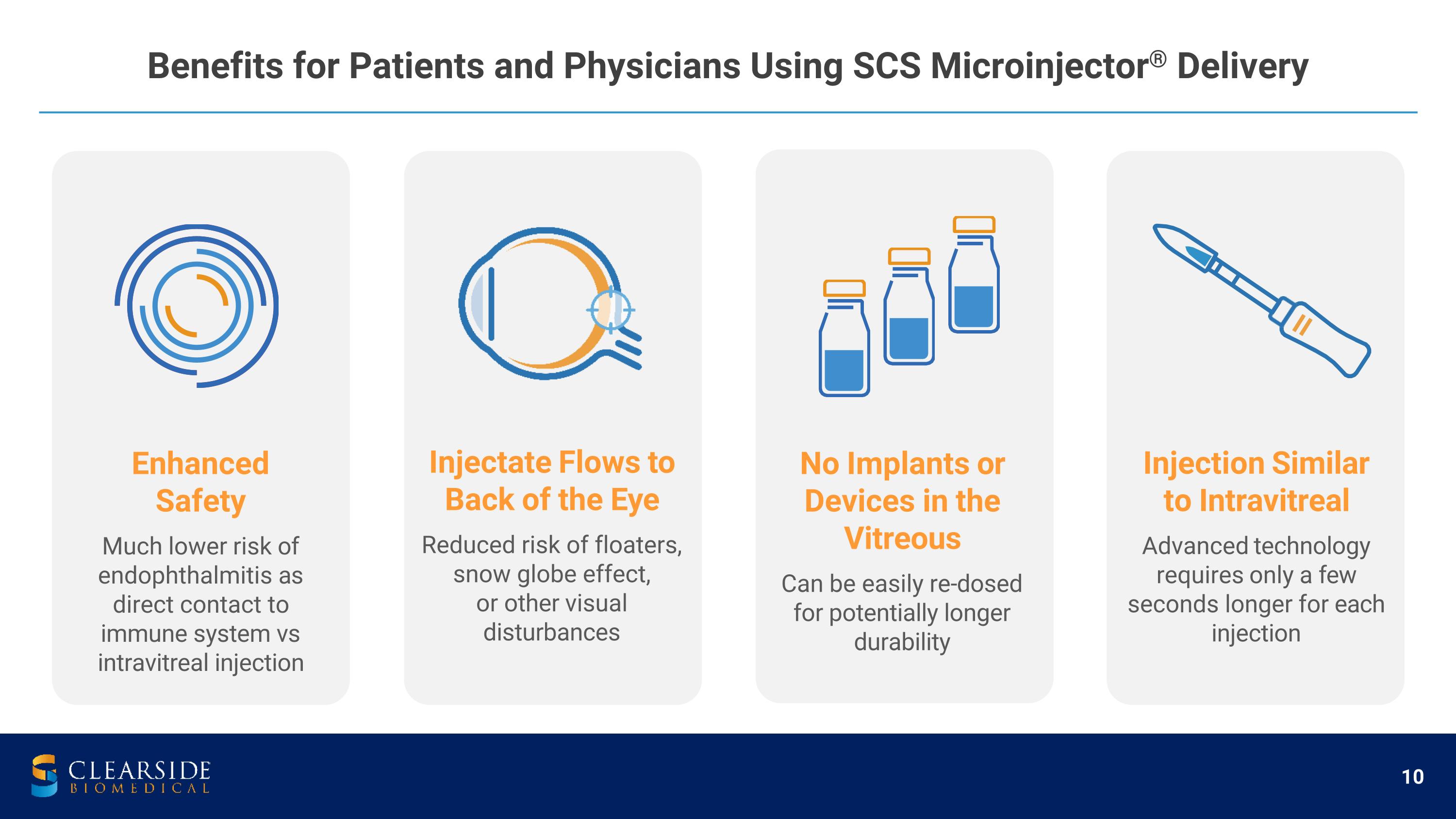
Benefits for Patients and Physicians Using SCS Microinjector® Delivery Enhanced Safety Much lower risk of endophthalmitis as direct contact to immune system vs intravitreal injection Injectate Flows to Back of the Eye Reduced risk of floaters, snow globe effect, or other visual disturbances No Implants or Devices in the Vitreous Can be easily re-dosed for potentially longer durability Injection Similar to Intravitreal Advanced technology requires only a few seconds longer for each injection

Abbreviations: UME = uveitic macular edema; DME = diabetic macular edema; DR = diabetic retinopathy; Sources: Clearside data on file | 1Kurup, et. al, Macula Society 2021 Safety of the Suprachoroidal Injection Procedure Utilizing SCS Microinjector® across Three Retinal Disorders. SCS Microinjector®: Drug/Device Combination with Proven Versatility Well-accepted by retinal physicians with thousands of injections performed Demonstrated ability for precise delivery into the suprachoroidal space Safety profile of SCS Microinjector comparable to intravitreal injections1 First and Only FDA-approved SCS product

Straightforward Suprachoroidal Injection Technique Hold the microinjector perpendicular �to the ocular surface Ensure firm contact with sclera by maintaining a dimple throughout injection Inject slowly over 5 – 10 seconds Perpendicular Dimple Slow Source: Clearside July 24, 2024 KOL Webinar

Clearside Needle Size Equivalent to Most Commonly Used Intravitreal Injections and Smaller than Other TKIs in development 22G 25G 30G Outer Diameter of the Needle Relative to the Ocular Tissue Inner Diameter of the Needle Drug Product Passage 30G needle results in less damage to the ocular tissue wound size to the ocular tissue is >4x greater with 22G Needle >2x greater with 25G Needle Clearside�SCS Microinjector® Gustavo Barreto Melo, et al. Progress in Retinal and Eye Research. “Critical analysis of techniques and materials used in devices, syringes, and needles used for intravitreal injections”. https://doi.org/10.1016/j.preteyeres.2020.100862

CLS-AX (axitinib injectable suspension) New mechanism of action with potential for longer duration of effect for the treatment of wet AMD
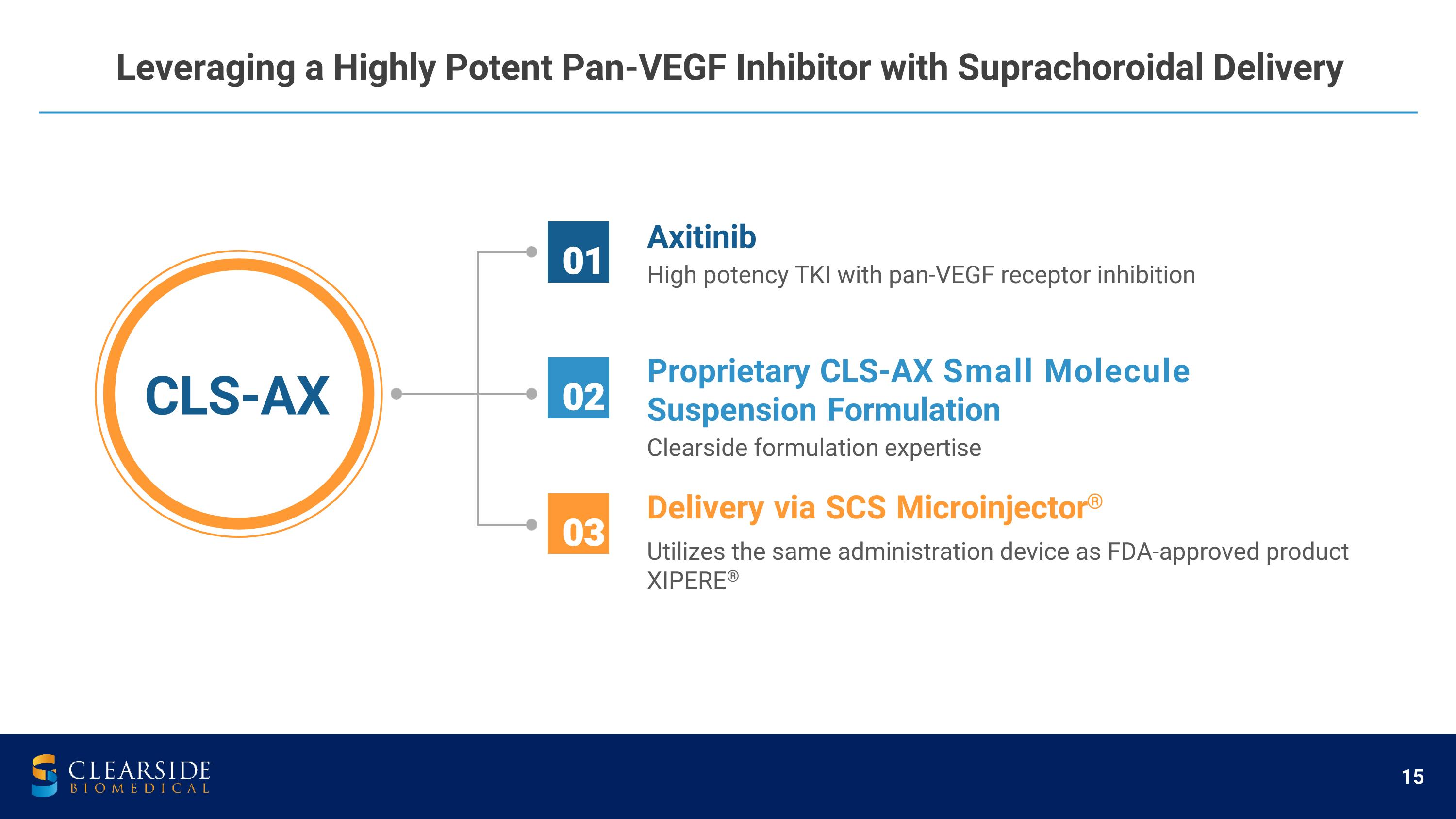
Leveraging a Highly Potent Pan-VEGF Inhibitor with Suprachoroidal Delivery Axitinib High potency TKI with pan-VEGF receptor inhibition Proprietary CLS-AX Small Molecule Suspension Formulation Clearside formulation expertise Delivery via SCS Microinjector® Utilizes the same administration device as FDA-approved product XIPERE® 01 02 03 CLS-AX
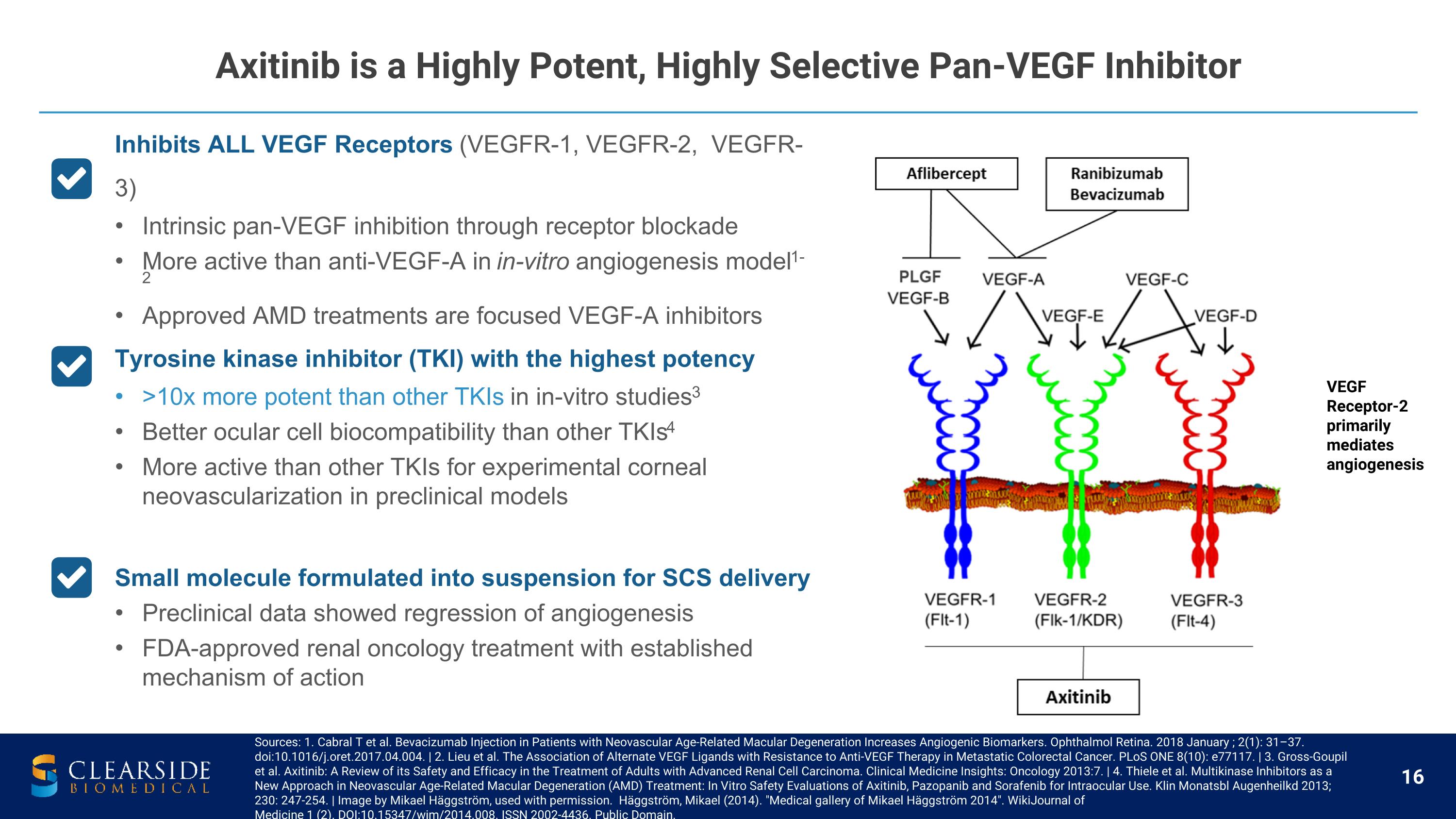
Axitinib is a Highly Potent, Highly Selective Pan-VEGF Inhibitor Inhibits ALL VEGF Receptors (VEGFR-1, VEGFR-2, VEGFR-3) Intrinsic pan-VEGF inhibition through receptor blockade More active than anti-VEGF-A in in-vitro angiogenesis model1-2 Approved AMD treatments are focused VEGF-A inhibitors Tyrosine kinase inhibitor (TKI) with the highest potency >10x more potent than other TKIs in in-vitro studies3 Better ocular cell biocompatibility than other TKIs4 More active than other TKIs for experimental corneal neovascularization in preclinical models Small molecule formulated into suspension for SCS delivery Preclinical data showed regression of angiogenesis FDA-approved renal oncology treatment with established mechanism of action Sources: 1. Cabral T et al. Bevacizumab Injection in Patients with Neovascular Age-Related Macular Degeneration Increases Angiogenic Biomarkers. Ophthalmol Retina. 2018 January ; 2(1): 31–37. doi:10.1016/j.oret.2017.04.004. | 2. Lieu et al. The Association of Alternate VEGF Ligands with Resistance to Anti-VEGF Therapy in Metastatic Colorectal Cancer. PLoS ONE 8(10): e77117. | 3. Gross-Goupil et al. Axitinib: A Review of its Safety and Efficacy in the Treatment of Adults with Advanced Renal Cell Carcinoma. Clinical Medicine Insights: Oncology 2013:7. | 4. Thiele et al. Multikinase Inhibitors as a New Approach in Neovascular Age-Related Macular Degeneration (AMD) Treatment: In Vitro Safety Evaluations of Axitinib, Pazopanib and Sorafenib for Intraocular Use. Klin Monatsbl Augenheilkd 2013; 230: 247-254. | Image by Mikael Häggström, used with permission. Häggström, Mikael (2014). "Medical gallery of Mikael Häggström 2014". WikiJournal of Medicine 1 (2). DOI:10.15347/wjm/2014.008. ISSN 2002-4436. Public Domain. VEGF Receptor-2 primarily mediates angiogenesis

Positioning CLS-AX for Real-World Success in the �$12 Billion Dollar Wet AMD Market1 1Annual financial reports from Regeneron Pharmaceuticals, Inc. and Genentech/Roche 2Dosing regimens are per respective product labels EYLEA® and EYLEA HD® are registered trademarks of Regeneron Pharmaceuticals| LUCENTIS® and VABYSMO® are registered trademarks of Genentech/Roche Maintain Vision & Reduce Office Visits Objective is to maintain visual acuity and reduce the number of injections; therefore, reducing the number of office visits Reduced treatment burden benefits patients, caregivers and payors with improved outcomes Ability to Re-dose Wet AMD is a chronic disease requiring ongoing treatment Goal is a label that allows re-dosing comparable to VABYSMO® and EYLEA HD® in the real-world setting Extend Duration Over Currently Approved Drugs 2x - 4x/year maintenance dosing anticipated for CLS-AX compared to approved drugs on label2: LUCENTIS®: 12x/year VABYSMO®: 3x - 12x/year EYLEA®: 6x - 12x/year EYLEA HD®: 3x - 6x/year
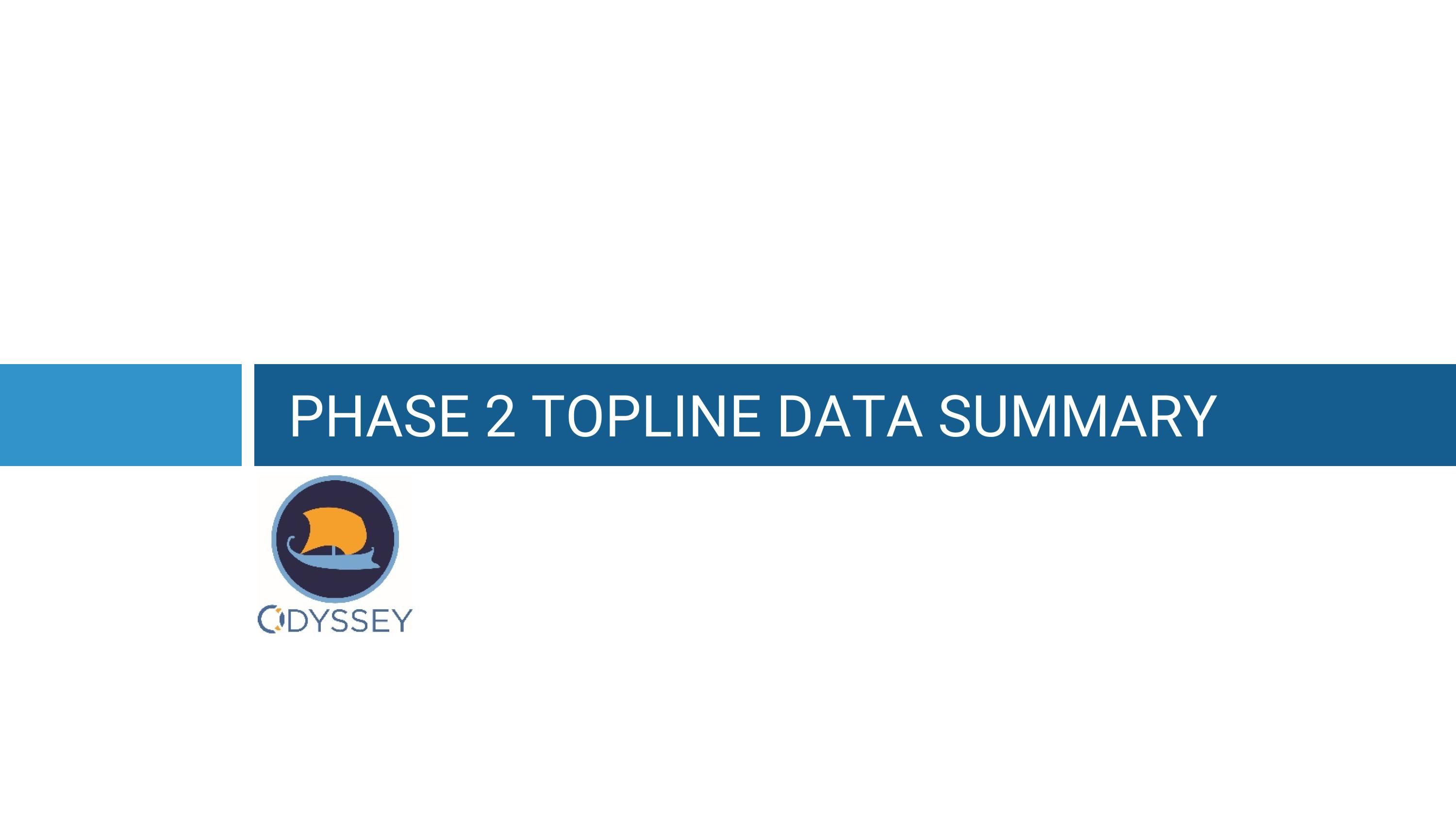
PHASE 2 TOPLINE DATA SUMMARY

Trial Objectives: Evaluated safety, efficacy & duration of CLS-AX in participants with wet AMD Primary Outcomes: Mean change in BCVA from Baseline to Week 36; Safety & tolerability Secondary Outcomes: Other changes in visual function and retinal imaging, including CST; Need for supplemental treatment; Treatment burden as measured by total injections Treatment experienced participants with reading center confirmation of persistent active disease Protocol required re-dosing with CLS-AX in study arm Participants received at least 2 doses of CLS-AX Provided important data to plan Phase 3 in chronic disease Participant Profile: 60 total with 2:1 randomization (40 in CLS-AX arm & 20 in aflibercept arm) ODYSSEY Phase 2b Clinical Trial Overview
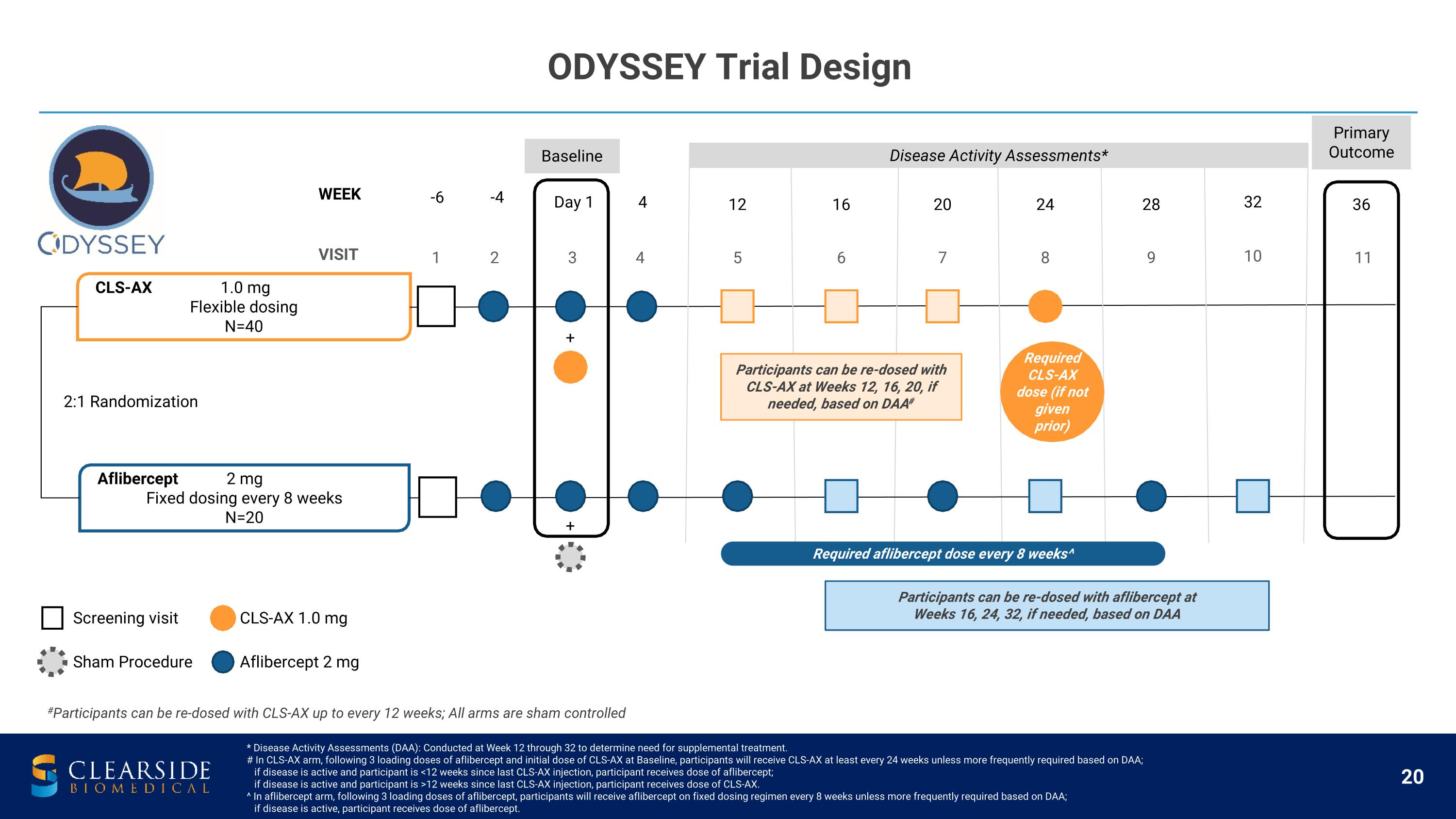
* Disease Activity Assessments (DAA): Conducted at Week 12 through 32 to determine need for supplemental treatment.�# In CLS-AX arm, following 3 loading doses of aflibercept and initial dose of CLS-AX at Baseline, participants will receive CLS-AX at least every 24 weeks unless more frequently required based on DAA; � if disease is active and participant is <12 weeks since last CLS-AX injection, participant receives dose of aflibercept; � if disease is active and participant is >12 weeks since last CLS-AX injection, participant receives dose of CLS-AX. ^ In aflibercept arm, following 3 loading doses of aflibercept, participants will receive aflibercept on fixed dosing regimen every 8 weeks unless more frequently required based on DAA; � if disease is active, participant receives dose of aflibercept. CLS-AX 1.0 mg Flexible dosing N=40 Aflibercept 2 mg Fixed dosing every 8 weeks N=20 VISIT 1 2 3 4 5 6 7 8 9 10 11 WEEK -6 -4 Day 1 4 12 16 20 24 28 32 36 + + Primary Outcome Disease Activity Assessments* Baseline 2:1 Randomization Sham Procedure CLS-AX 1.0 mg Aflibercept 2 mg Screening visit Required aflibercept dose every 8 weeks^ ODYSSEY Trial Design Required CLS-AX dose (if not given prior) #Participants can be re-dosed with CLS-AX up to every 12 weeks; All arms are sham controlled Participants can be re-dosed with CLS-AX at Weeks 12, 16, 20, if needed, based on DAA# Participants can be re-dosed with aflibercept at Weeks 16, 24, 32, if needed, based on DAA
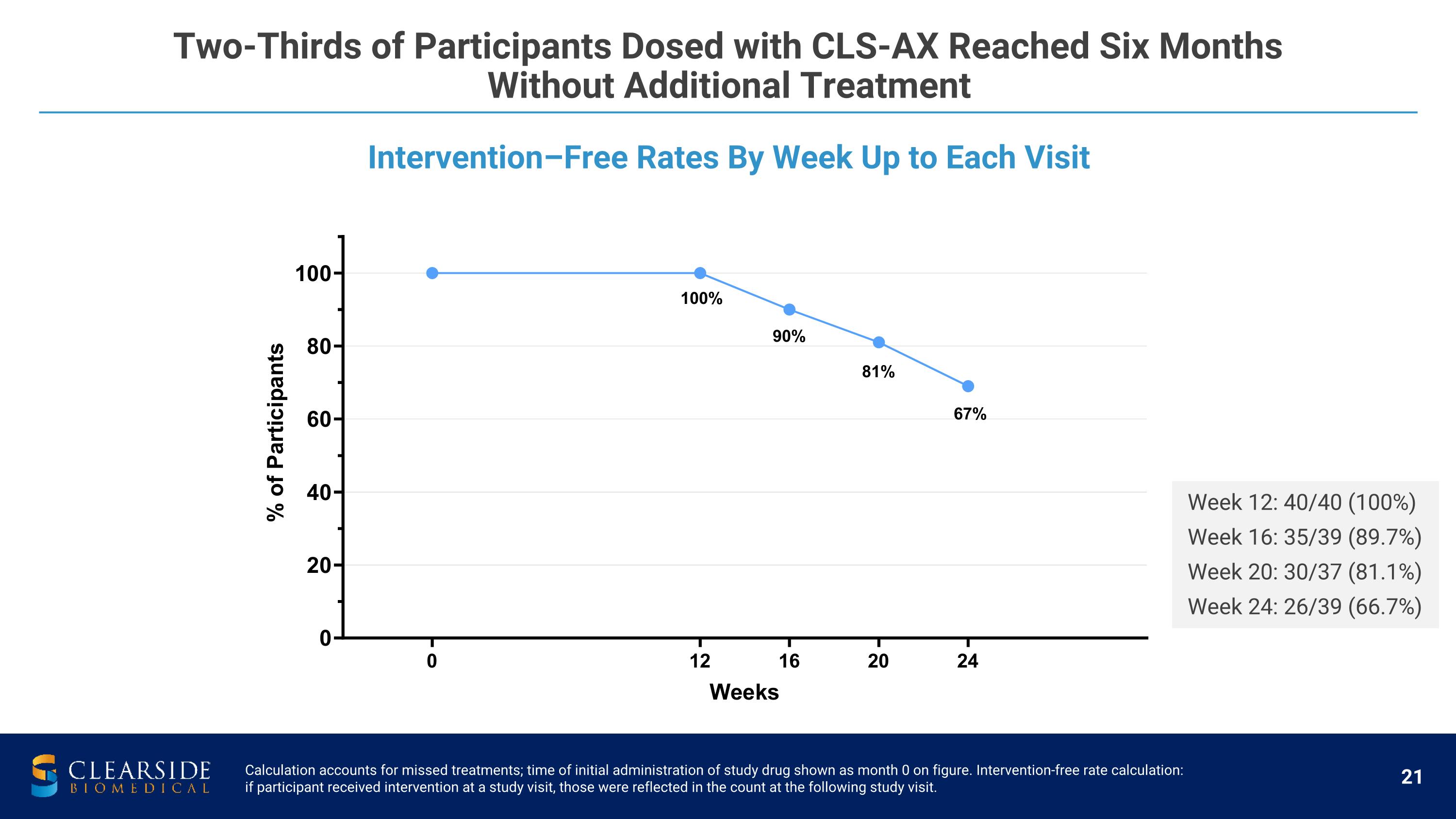
Intervention–Free Rates By Week Up to Each Visit Two-Thirds of Participants Dosed with CLS-AX Reached Six Months �Without Additional Treatment Calculation accounts for missed treatments; time of initial administration of study drug shown as month 0 on figure. Intervention-free rate calculation: if participant received intervention at a study visit, those were reflected in the count at the following study visit. Week 12: 40/40 (100%) Week 16: 35/39 (89.7%) Week 20: 30/37 (81.1%) Week 24: 26/39 (66.7%)

Comparative TKI Intervention Free Rate Over 6 Months Results based on publicly available information provided by each company as of February 2025. Data presented above is not based on head-to-head studies and may not be directly comparable. EyePoint is pooled 2mg and 3mg;.

24 Weeks Before and After CLS-AX Consistently Reduced the Frequency of Injections Comparison of Wet AMD Treatments Pre- and Post- Randomization Injection post Baseline includes re-dosing with CLS-AX and/or supplementary treatment with aflibercept. Injection frequency reduction calculated by the average number of treatments 24 Weeks prior to Screening Visit as compared to average number of treatments up to 24 Weeks after Baseline Visit. Average number of treatments 24 Weeks prior to Screening Visit: 2.95 injections Average number of treatments up to 24 Weeks after Baseline Visit: 0.475 injections Reduced injection frequency by 84%
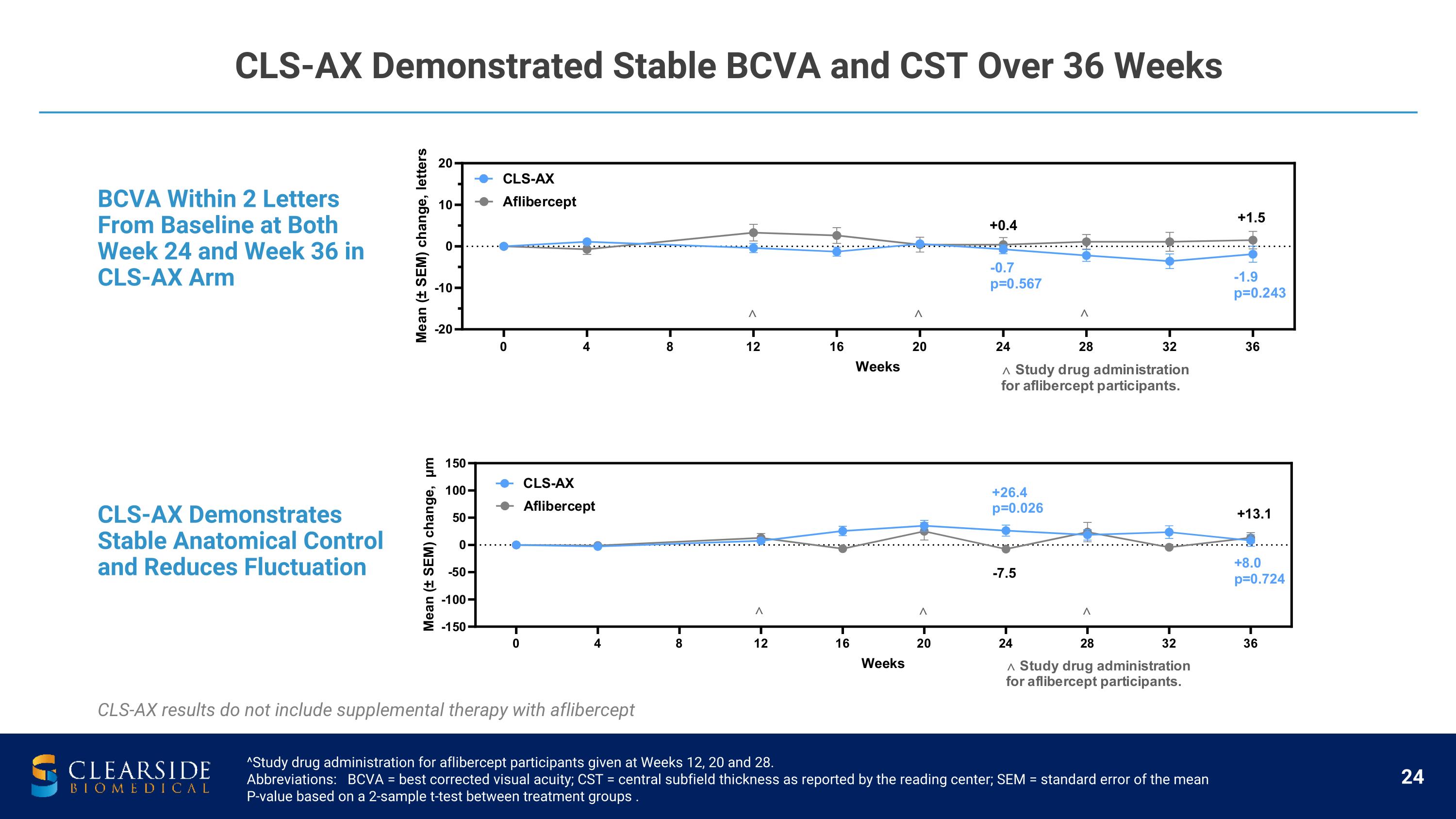
CLS-AX Demonstrated Stable BCVA and CST Over 36 Weeks ^Study drug administration for aflibercept participants given at Weeks 12, 20 and 28. Abbreviations: BCVA = best corrected visual acuity; CST = central subfield thickness as reported by the reading center; SEM = standard error of the mean P-value based on a 2-sample t-test between treatment groups . CLS-AX results do not include supplemental therapy with aflibercept BCVA Within 2 Letters From Baseline at Both Week 24 and Week 36 in CLS-AX Arm CLS-AX Demonstrates Stable Anatomical Control and Reduces Fluctuation
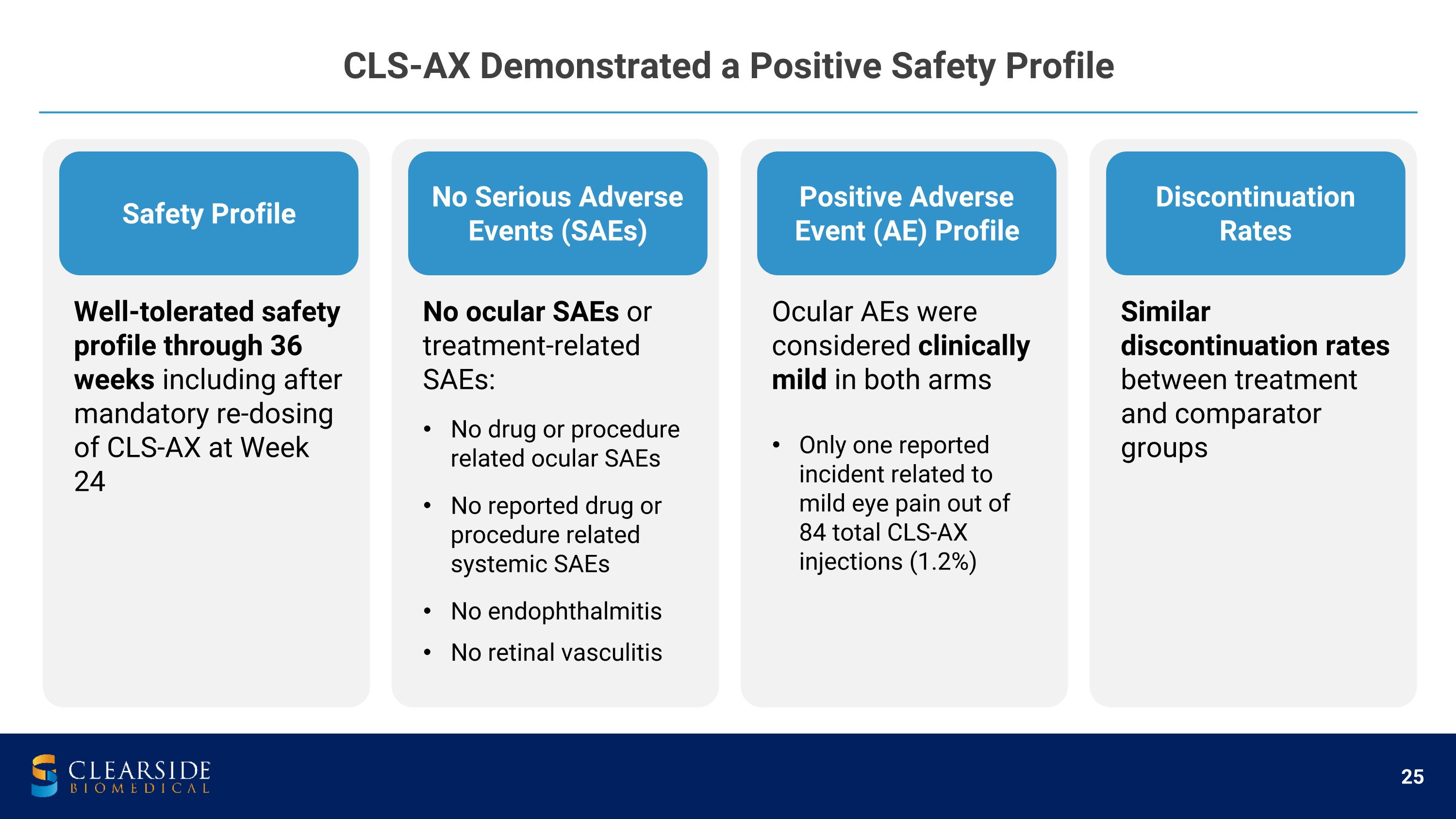
CLS-AX Demonstrated a Positive Safety Profile Safety Profile Well-tolerated safety profile through 36 weeks including after mandatory re-dosing of CLS-AX at Week 24 No Serious Adverse Events (SAEs) No ocular SAEs or treatment-related SAEs: No drug or procedure related ocular SAEs
No reported drug or procedure related systemic SAEs No endophthalmitis No retinal vasculitis Positive Adverse Event (AE) Profile Ocular AEs were considered clinically mild in both arms Only one reported incident related to �mild eye pain out of �84 total CLS-AX injections (1.2%) Discontinuation Rates Similar discontinuation rates between treatment and comparator groups
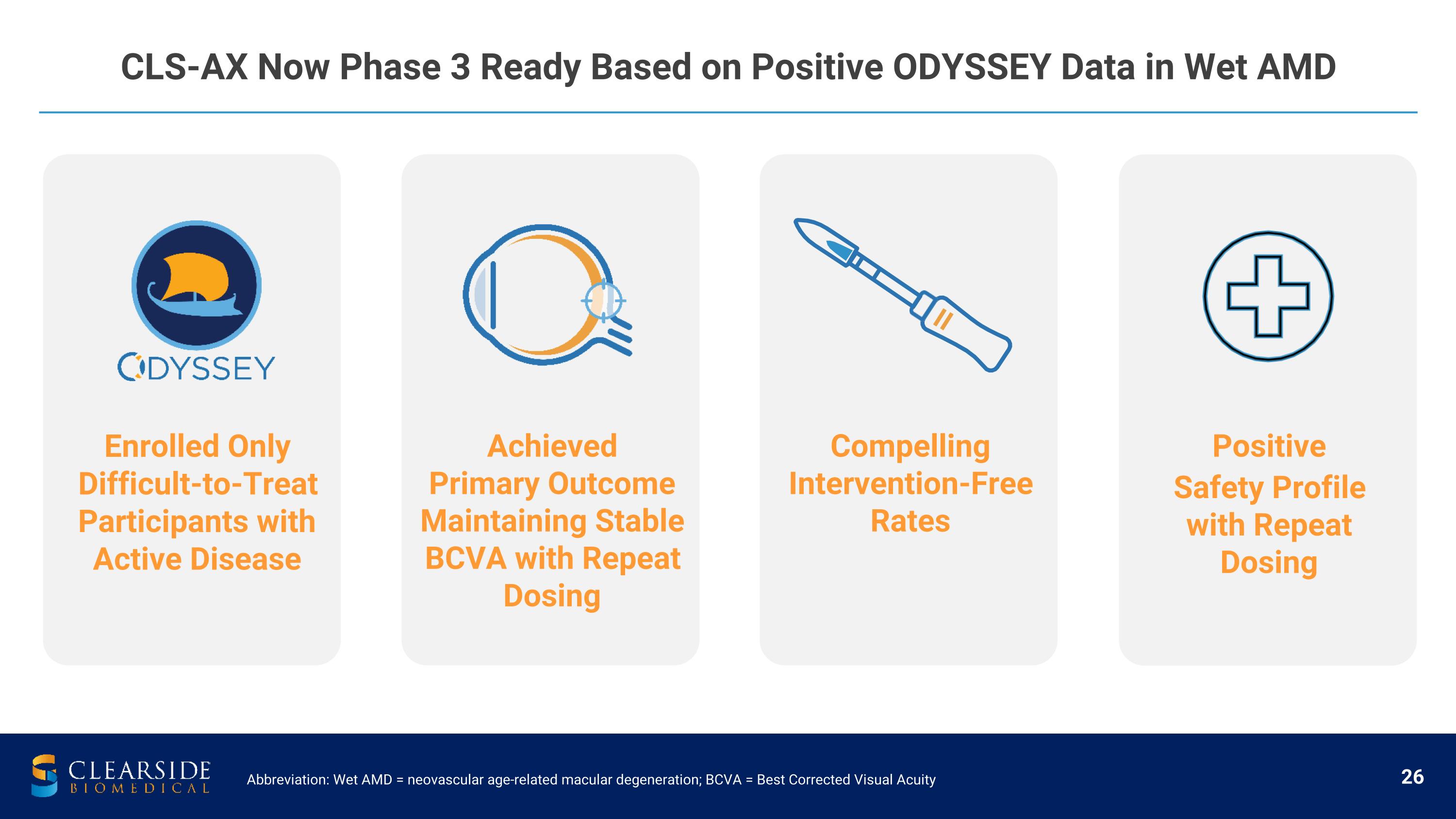
CLS-AX Now Phase 3 Ready Based on Positive ODYSSEY Data in Wet AMD Enrolled Only Difficult-to-Treat Participants with Active Disease Achieved Primary Outcome Maintaining Stable BCVA with Repeat Dosing Compelling Intervention-Free Rates Abbreviation: Wet AMD = neovascular age-related macular degeneration; BCVA = Best Corrected Visual Acuity Positive Safety Profile with Repeat Dosing

CLS-AX Phase 3 Program Current Plans Phase 3 plans are in development and subject to change

CLS-AX Phase 3 To Feature the Flexible Dosing of a �Biologic with the Duration of a TKI Two pivotal, non-inferiority trials in treatment naïve participants CLS-AX flexible dosing is an important differentiation vs other TKI programs Similar to Phase 3 trial design of EYLEA HD and VABYSMO in maintenance phase Employ more “real world” clinical practice re-dosing criteria for CLS-AX Successful End-of-Phase 2 FDA Meeting confirms Phase 3 program Preparations for Phase 3 program ongoing
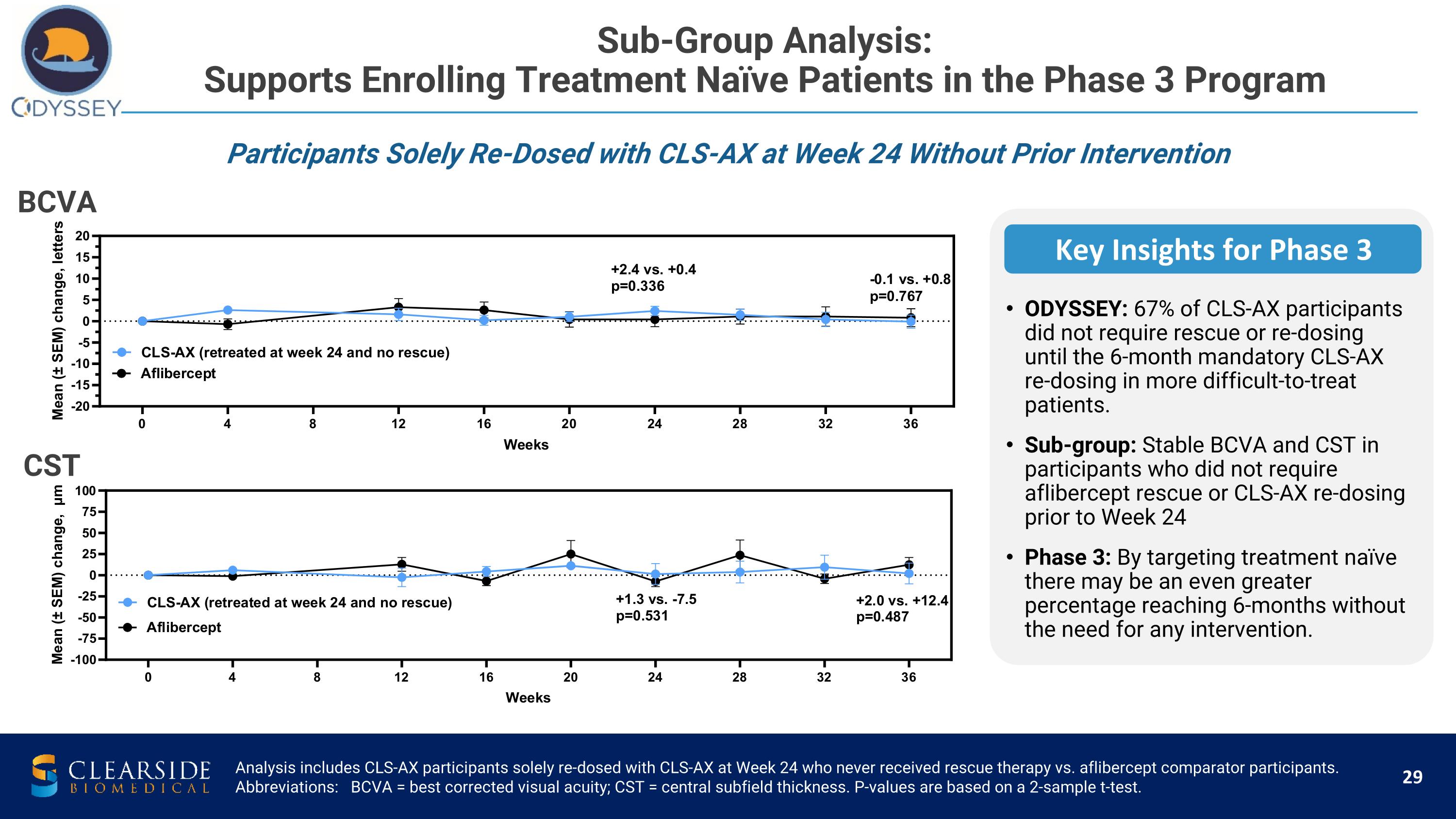
Participants Solely Re-Dosed with CLS-AX at Week 24 Without Prior Intervention Sub-Group Analysis: �Supports Enrolling Treatment Naïve Patients in the Phase 3 Program Analysis includes CLS-AX participants solely re-dosed with CLS-AX at Week 24 who never received rescue therapy vs. aflibercept comparator participants. Abbreviations: BCVA = best corrected visual acuity; CST = central subfield thickness. P-values are based on a 2-sample t-test. Key Insights for Phase 3 ODYSSEY: 67% of CLS-AX participants did not require rescue or re-dosing until the 6-month mandatory CLS-AX re-dosing in more difficult-to-treat patients. Sub-group: Stable BCVA and CST in participants who did not require aflibercept rescue or CLS-AX re-dosing prior to Week 24 Phase 3: By targeting treatment naïve there may be an even greater percentage reaching 6-months without the need for any intervention. BCVA CST
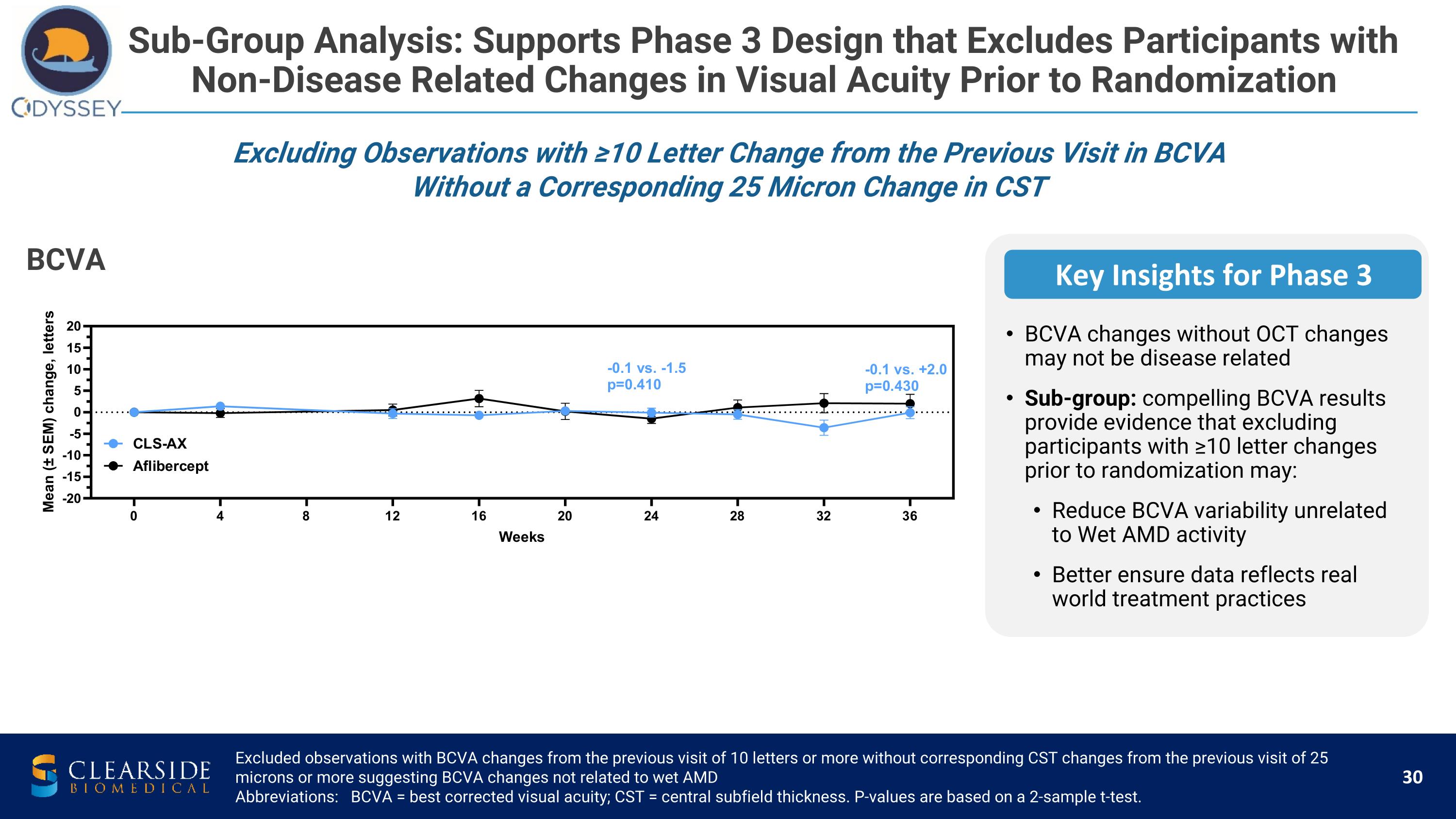
Excluding Observations with ≥10 Letter Change from the Previous Visit in BCVA Without a Corresponding 25 Micron Change in CST Sub-Group Analysis: Supports Phase 3 Design that Excludes Participants with Non-Disease Related Changes in Visual Acuity Prior to Randomization Key Insights for Phase 3 BCVA changes without OCT changes may not be disease related Sub-group: compelling BCVA results provide evidence that excluding participants with ≥10 letter changes prior to randomization may: Reduce BCVA variability unrelated to Wet AMD activity Better ensure data reflects real world treatment practices BCVA Excluded observations with BCVA changes from the previous visit of 10 letters or more without corresponding CST changes from the previous visit of 25 microns or more suggesting BCVA changes not related to wet AMD Abbreviations: BCVA = best corrected visual acuity; CST = central subfield thickness. P-values are based on a 2-sample t-test.
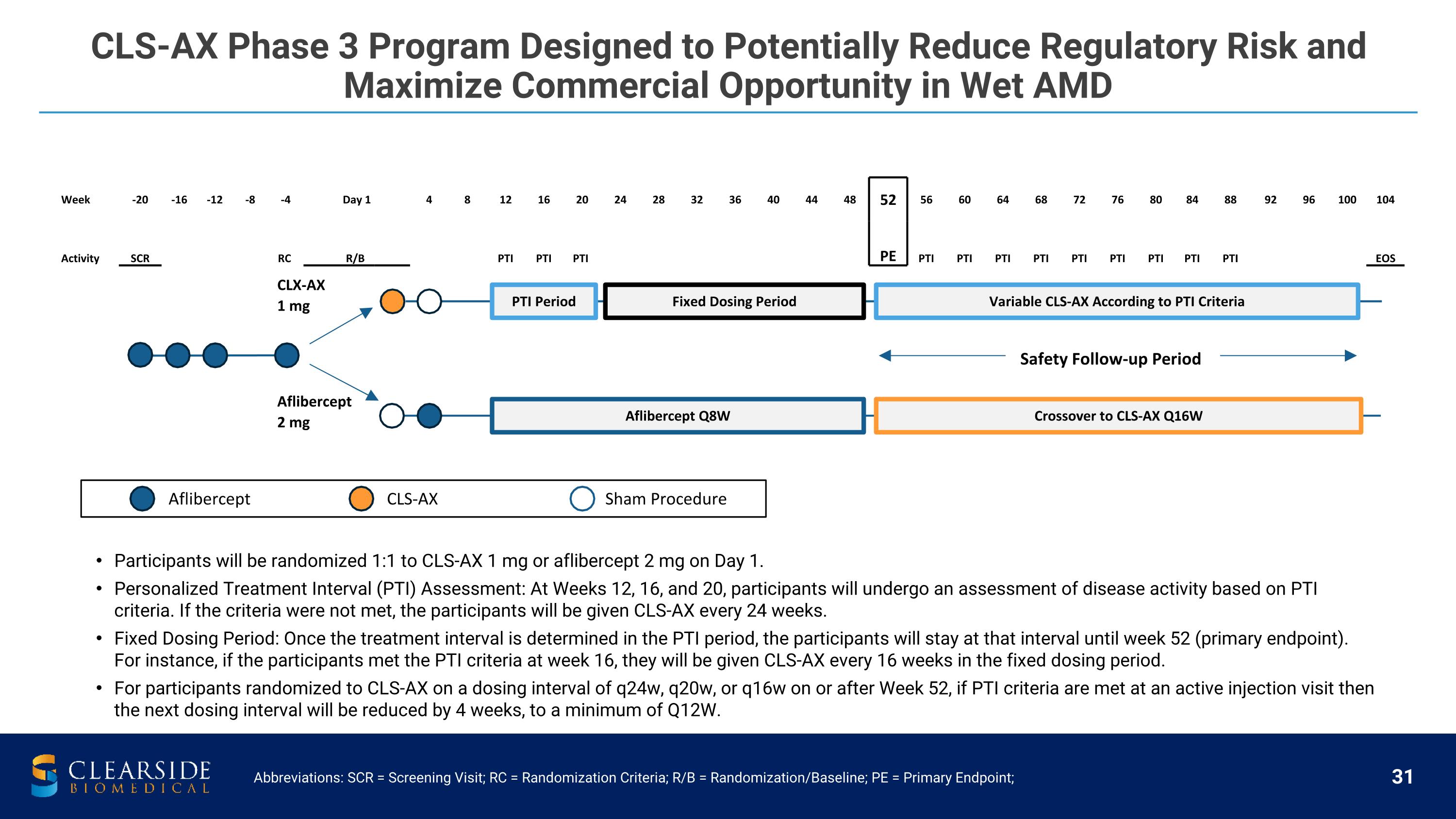
CLS-AX Phase 3 Program Designed to Potentially Reduce Regulatory Risk and �Maximize Commercial Opportunity in Wet AMD Aflibercept CLS-AX Sham Procedure Abbreviations: SCR = Screening Visit; RC = Randomization Criteria; R/B = Randomization/Baseline; PE = Primary Endpoint; Participants will be randomized 1:1 to CLS-AX 1 mg or aflibercept 2 mg on Day 1. Personalized Treatment Interval (PTI) Assessment: At Weeks 12, 16, and 20, participants will undergo an assessment of disease activity based on PTI criteria. If the criteria were not met, the participants will be given CLS-AX every 24 weeks. Fixed Dosing Period: Once the treatment interval is determined in the PTI period, the participants will stay at that interval until week 52 (primary endpoint). For instance, if the participants met the PTI criteria at week 16, they will be given CLS-AX every 16 weeks in the fixed dosing period. For participants randomized to CLS-AX on a dosing interval of q24w, q20w, or q16w on or after Week 52, if PTI criteria are met at an active injection visit then the next dosing interval will be reduced by 4 weeks, to a minimum of Q12W. Week -20 -16 -12 -8 -4 Day 1 4 8 12 16 20 24 28 32 36 40 44 48 52 56 60 64 68 72 76 80 84 88 92 96 100 104 Activity SCR RC R/B PTI PTI PTI PE PTI PTI PTI PTI PTI PTI PTI PTI PTI EOS CLX-AX �1 mg Aflibercept 2 mg Safety Follow-up Period Variable CLS-AX According to PTI Criteria Crossover to CLS-AX Q16W Aflibercept Q8W PTI Period Fixed Dosing Period
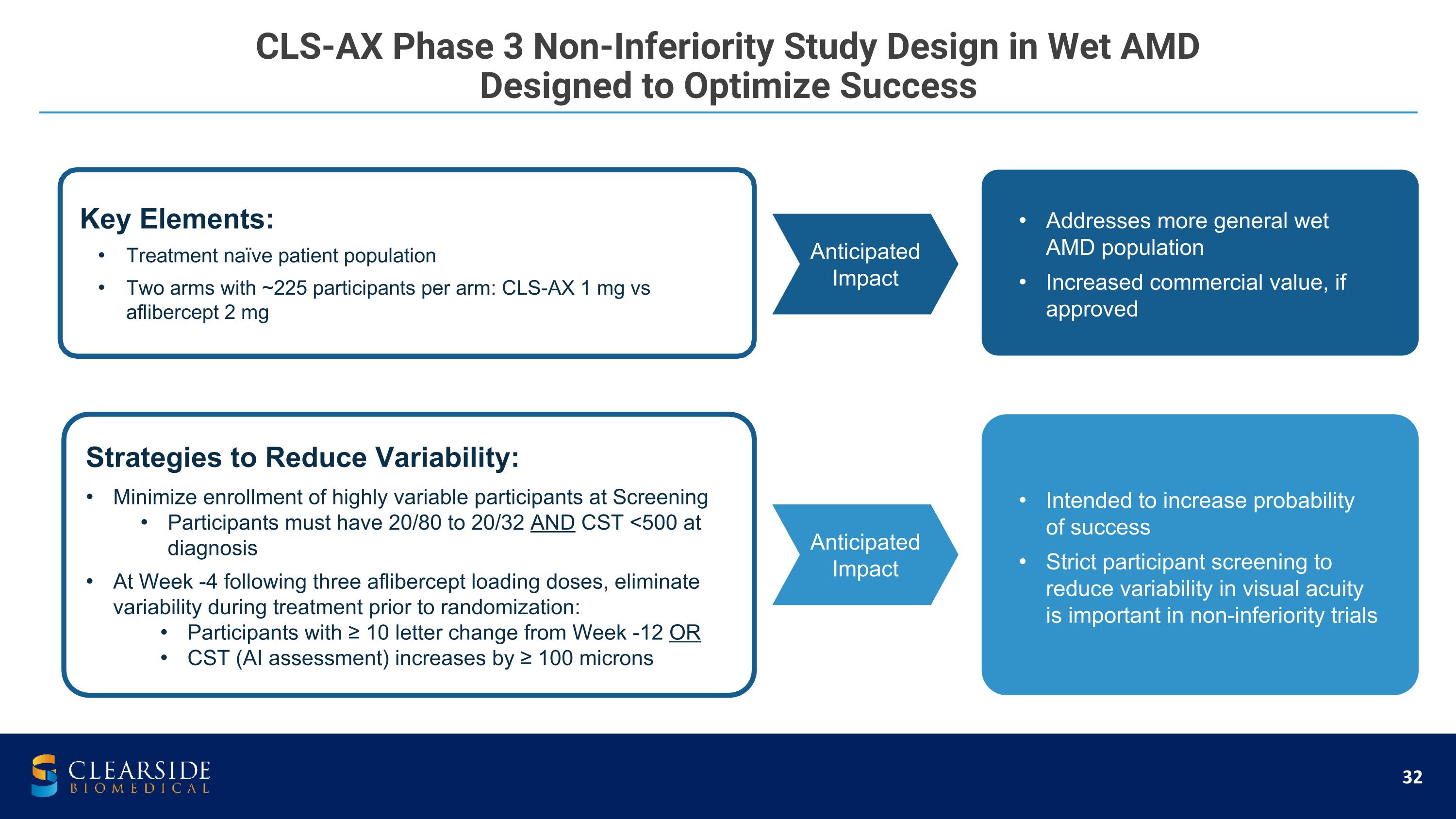
CLS-AX Phase 3 Non-Inferiority Study Design in Wet AMD�Designed to Optimize Success Strategies to Reduce Variability: Minimize enrollment of highly variable participants at Screening Participants must have 20/80 to 20/32 AND CST <500 at diagnosis At Week -4 following three aflibercept loading doses, eliminate variability during treatment prior to randomization: Participants with ≥ 10 letter change from Week -12 OR CST (AI assessment) increases by ≥ 100 microns Addresses more general wet AMD population Increased commercial value, if approved Key Elements: Treatment naïve patient population Two arms with ~225 participants per arm: CLS-AX 1 mg vs aflibercept 2 mg Intended to increase probability of success Strict participant screening to reduce variability in visual acuity is important in non-inferiority trials Anticipated Impact Anticipated Impact
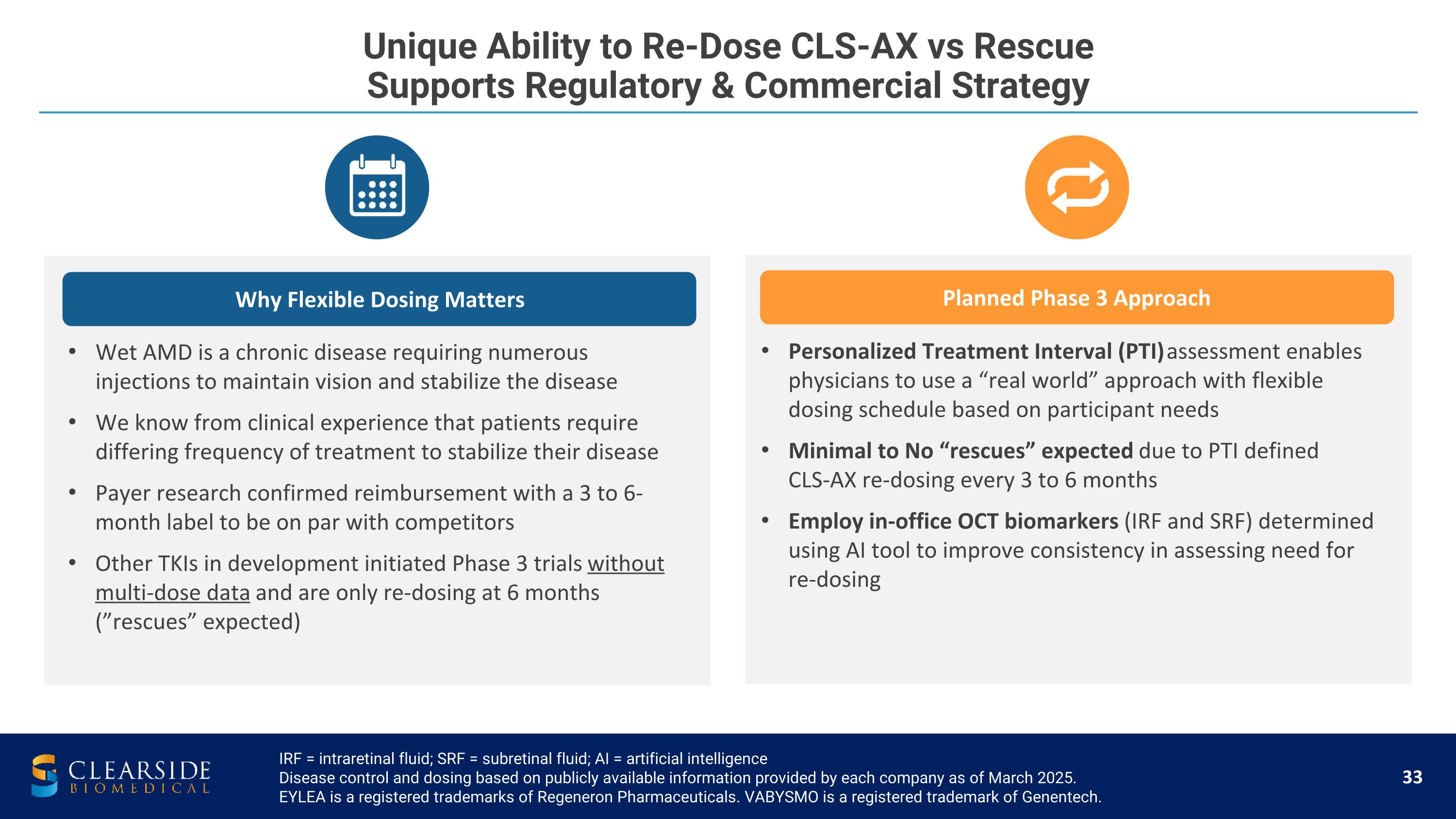
Unique Ability to Re-Dose CLS-AX vs Rescue �Supports Regulatory & Commercial Strategy Why Flexible Dosing Matters Planned Phase 3 Approach Wet AMD is a chronic disease requiring numerous injections to maintain vision and stabilize the disease We know from clinical experience that patients require differing frequency of treatment to stabilize their disease Payer research confirmed reimbursement with a 3 to 6-month label to be on par with competitors Other TKIs in development initiated Phase 3 trials without multi-dose data and are only re-dosing at 6 months (”rescues” expected) Personalized Treatment Interval (PTI) assessment enables physicians to use a “real world” approach with flexible dosing schedule based on participant needs Minimal to No “rescues” expected due to PTI defined CLS-AX re-dosing every 3 to 6 months Employ in-office OCT biomarkers (IRF and SRF) determined using AI tool to improve consistency in assessing need for re-dosing IRF = intraretinal fluid; SRF = subretinal fluid; AI = artificial intelligence Disease control and dosing based on publicly available information provided by each company as of March 2025. EYLEA is a registered trademarks of Regeneron Pharmaceuticals. VABYSMO is a registered trademark of Genentech.
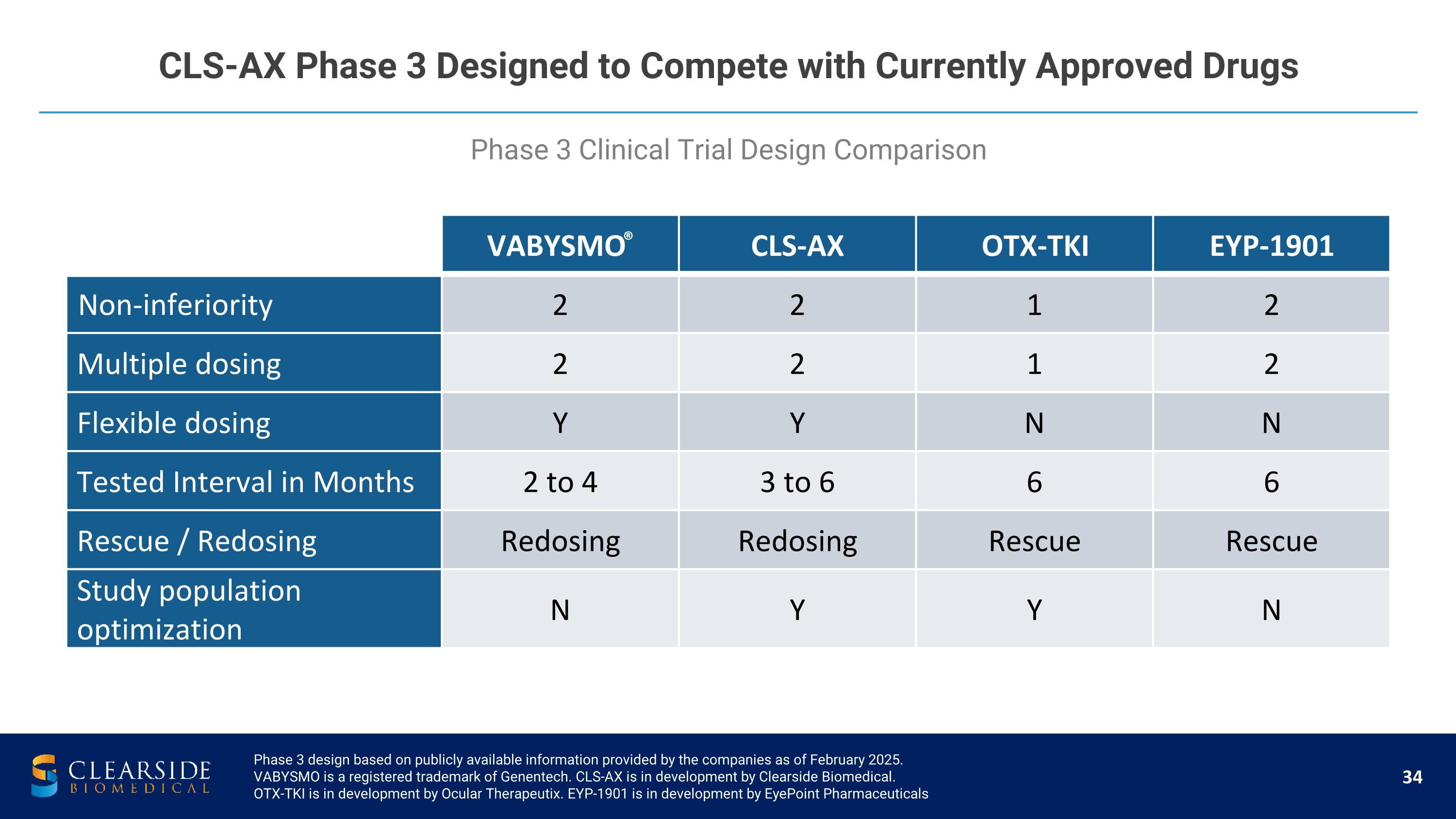
VABYSMO® CLS-AX OTX-TKI EYP-1901 Non-inferiority 2 2 1 2 Multiple dosing 2 2 1 2 Flexible dosing Y Y N N Tested Interval in Months 2 to 4 3 to 6 6 6 Rescue / Redosing Redosing Redosing Rescue Rescue Study population optimization N Y Y N CLS-AX Phase 3 Designed to Compete with Currently Approved Drugs Phase 3 design based on publicly available information provided by the companies as of February 2025. VABYSMO is a registered trademark of Genentech. CLS-AX is in development by Clearside Biomedical. �OTX-TKI is in development by Ocular Therapeutix. EYP-1901 is in development by EyePoint Pharmaceuticals Phase 3 Clinical Trial Design Comparison
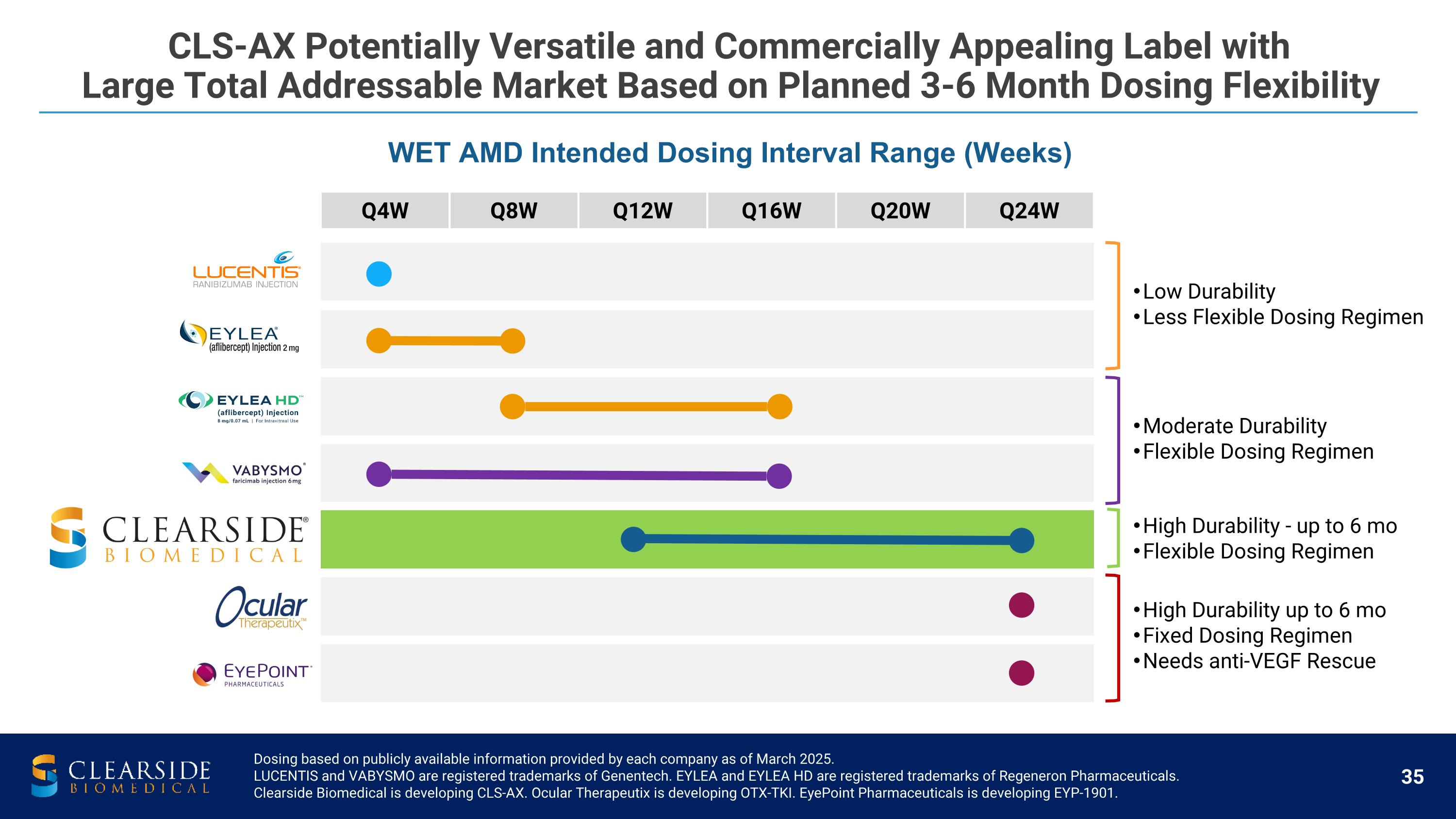
WET AMD Intended Dosing Interval Range (Weeks) CLS-AX Potentially Versatile and Commercially Appealing Label with�Large Total Addressable Market Based on Planned 3-6 Month Dosing Flexibility Q4W Q8W Q12W Q16W Q20W Q24W Dosing based on publicly available information provided by each company as of March 2025. LUCENTIS and VABYSMO are registered trademarks of Genentech. EYLEA and EYLEA HD are registered trademarks of Regeneron Pharmaceuticals. Clearside Biomedical is developing CLS-AX. Ocular Therapeutix is developing OTX-TKI. EyePoint Pharmaceuticals is developing EYP-1901. Low Durability Less Flexible Dosing Regimen Moderate Durability Flexible Dosing Regimen High Durability - up to 6 mo Flexible Dosing Regimen High Durability up to 6 mo Fixed Dosing Regimen Needs anti-VEGF Rescue
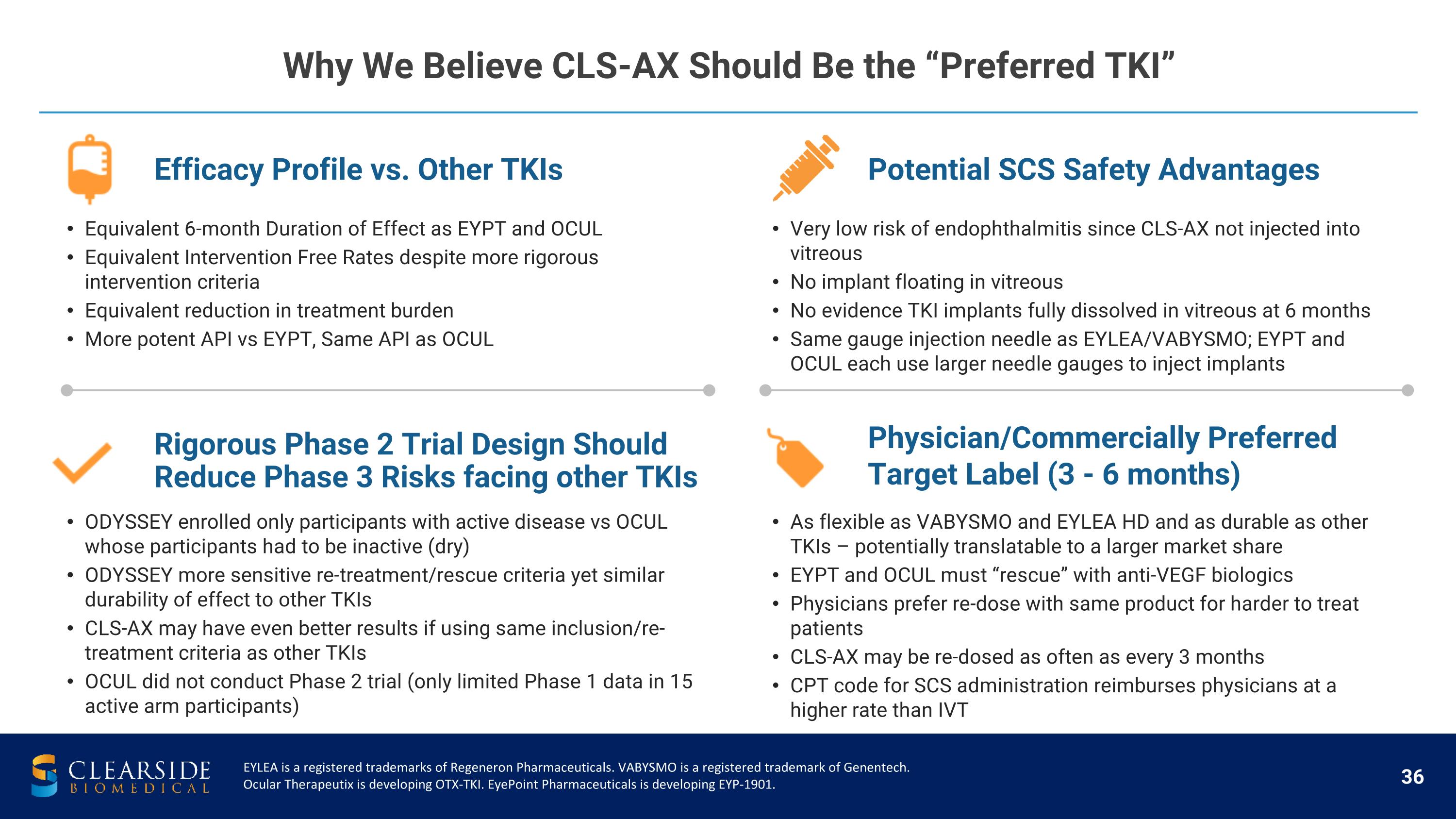
Why We Believe CLS-AX Should Be the “Preferred TKI” Efficacy Profile vs. Other TKIs Potential SCS Safety Advantages Rigorous Phase 2 Trial Design Should Reduce Phase 3 Risks facing other TKIs Physician/Commercially Preferred Target Label (3 - 6 months) As flexible as VABYSMO and EYLEA HD and as durable as other TKIs – potentially translatable to a larger market share EYPT and OCUL must “rescue” with anti-VEGF biologics Physicians prefer re-dose with same product for harder to treat patients CLS-AX may be re-dosed as often as every 3 months CPT code for SCS administration reimburses physicians at a higher rate than IVT ODYSSEY enrolled only participants with active disease vs OCUL whose participants had to be inactive (dry) ODYSSEY more sensitive re-treatment/rescue criteria yet similar durability of effect to other TKIs CLS-AX may have even better results if using same inclusion/re-treatment criteria as other TKIs OCUL did not conduct Phase 2 trial (only limited Phase 1 data in 15 active arm participants) Equivalent 6-month Duration of Effect as EYPT and OCUL Equivalent Intervention Free Rates despite more rigorous intervention criteria Equivalent reduction in treatment burden More potent API vs EYPT, Same API as OCUL Very low risk of endophthalmitis since CLS-AX not injected into vitreous No implant floating in vitreous No evidence TKI implants fully dissolved in vitreous at 6 months Same gauge injection needle as EYLEA/VABYSMO; EYPT and OCUL each use larger needle gauges to inject implants EYLEA is a registered trademarks of Regeneron Pharmaceuticals. VABYSMO is a registered trademark of Genentech. Ocular Therapeutix is developing OTX-TKI. EyePoint Pharmaceuticals is developing EYP-1901.

Pipeline Expansion Opportunity in Geographic Atrophy
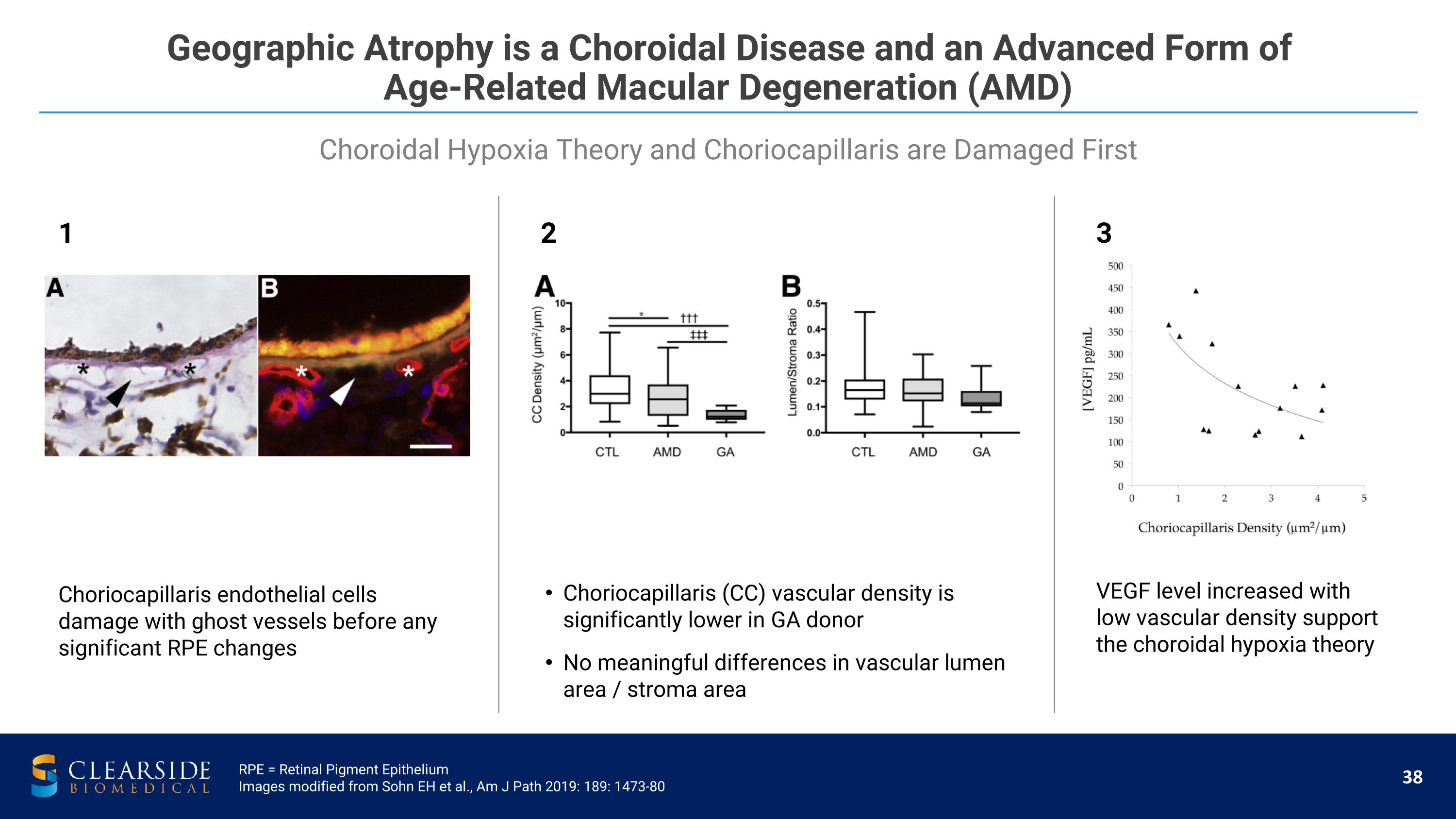
Choroidal Hypoxia Theory and Choriocapillaris are Damaged First Geographic Atrophy is a Choroidal Disease and an Advanced Form of �Age-Related Macular Degeneration (AMD) Choriocapillaris endothelial cells damage with ghost vessels before any significant RPE changes Choriocapillaris (CC) vascular density is significantly lower in GA donor No meaningful differences in vascular lumen area / stroma area 1 VEGF level increased with low vascular density support the choroidal hypoxia theory 2 3 RPE = Retinal Pigment Epithelium Images modified from Sohn EH et al., Am J Path 2019: 189: 1473-80
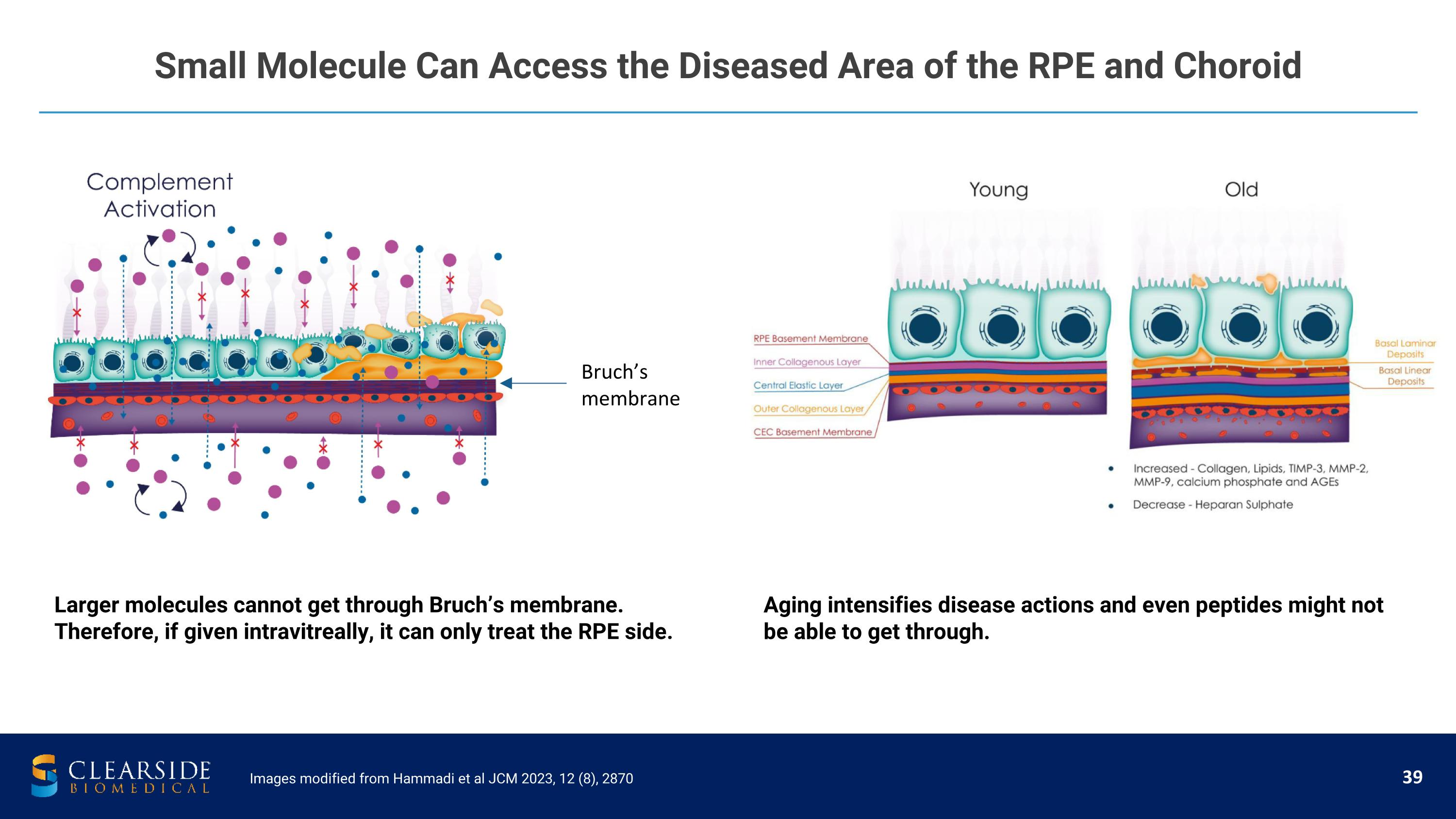
Larger molecules cannot get through Bruch’s membrane. Therefore, if given intravitreally, it can only treat the RPE side. Aging intensifies disease actions and even peptides might not be able to get through. Small Molecule Can Access the Diseased Area of the RPE and Choroid Images modified from Hammadi et al JCM 2023, 12 (8), 2870 Bruch’s membrane
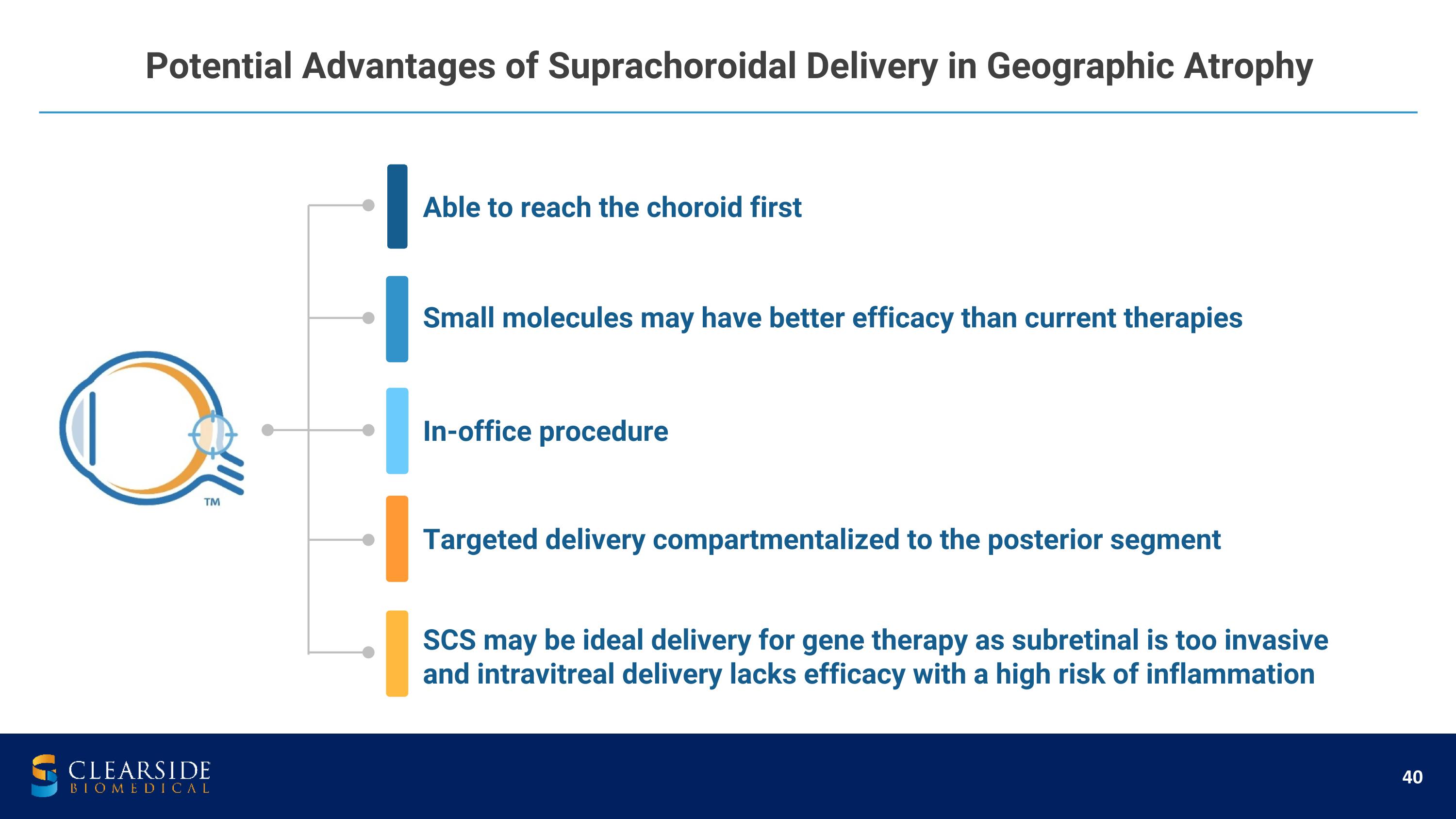
Potential Advantages of Suprachoroidal Delivery in Geographic Atrophy In-office procedure Small molecules may have better efficacy than current therapies SCS may be ideal delivery for gene therapy as subretinal is too invasive �and intravitreal delivery lacks efficacy with a high risk of inflammation Targeted delivery compartmentalized to the posterior segment Able to reach the choroid first
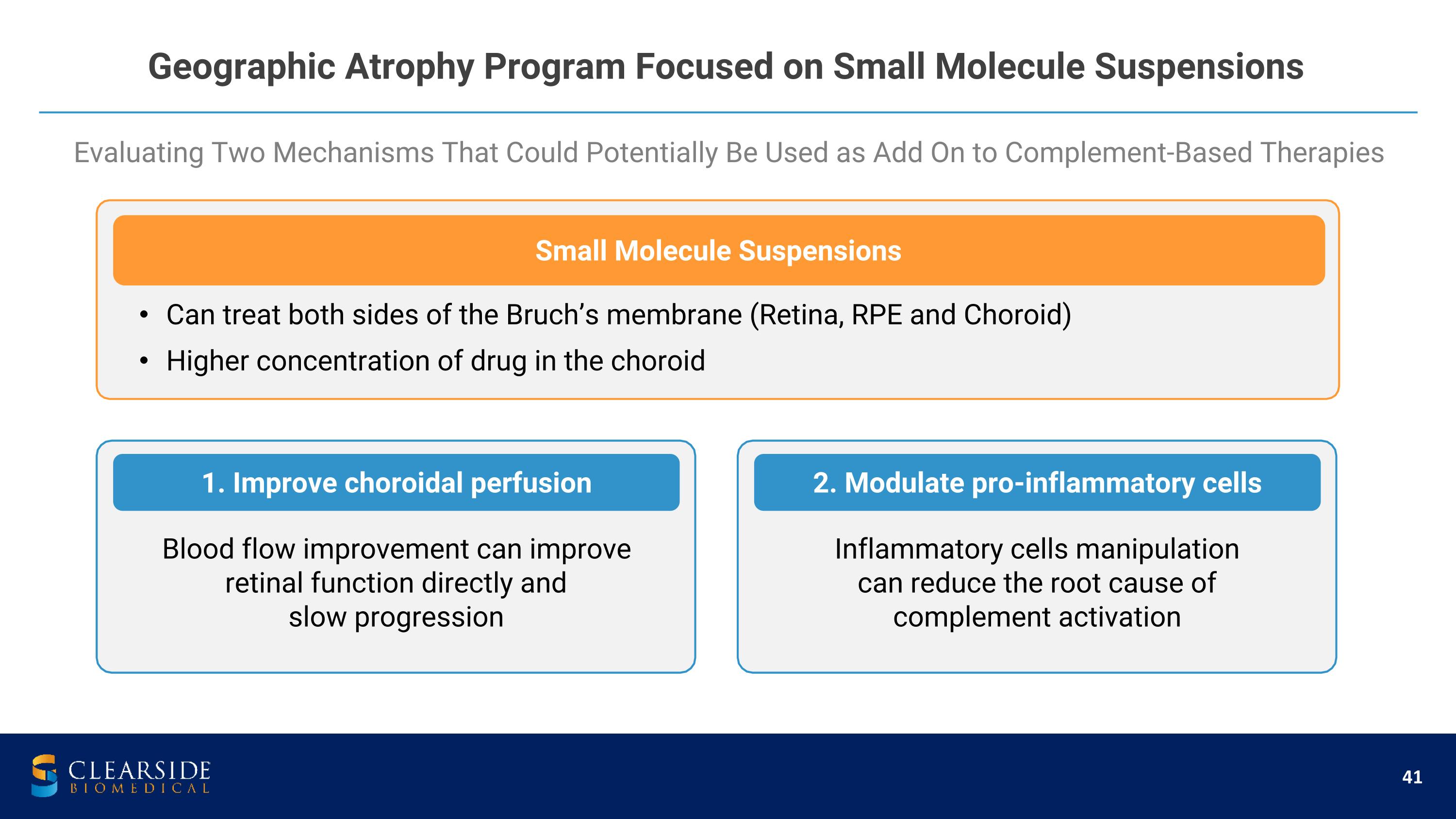
Geographic Atrophy Program Focused on Small Molecule Suspensions Small Molecule Suspensions Can treat both sides of the Bruch’s membrane (Retina, RPE and Choroid) Higher concentration of drug in the choroid 1. Improve choroidal perfusion Blood flow improvement can improve retinal function directly and slow progression Evaluating Two Mechanisms That Could Potentially Be Used as Add On to Complement-Based Therapies 2. Modulate pro-inflammatory cells Inflammatory cells manipulation can reduce the root cause of complement activation

Summary
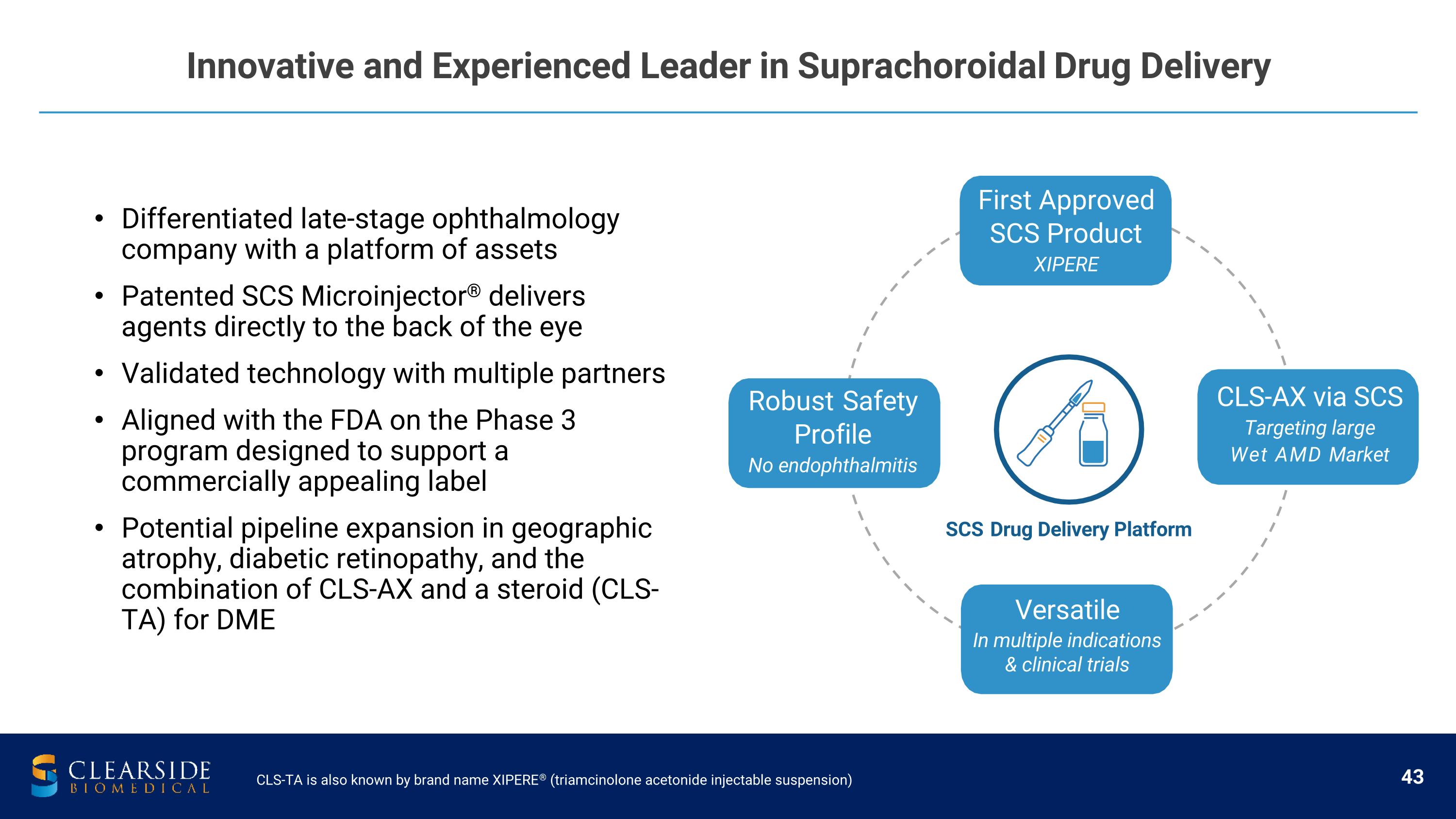
Differentiated late-stage ophthalmology company with a platform of assets Patented SCS Microinjector® delivers agents directly to the back of the eye Validated technology with multiple partners Aligned with the FDA on the Phase 3 program designed to support a commercially appealing label Potential pipeline expansion in geographic atrophy, diabetic retinopathy, and the combination of CLS-AX and a steroid (CLS-TA) for DME Innovative and Experienced Leader in Suprachoroidal Drug Delivery First Approved SCS Product XIPERE Versatile In multiple indications & clinical trials CLS-AX via SCS Targeting large Wet AMD Market Robust Safety Profile No endophthalmitis SCS Drug Delivery Platform CLS-TA is also known by brand name XIPERE® (triamcinolone acetonide injectable suspension)

Nasdaq: CLSD TM
v3.25.1
Document And Entity Information
|
Mar. 27, 2025 |
| Cover [Abstract] |
|
| Document Type |
8-K
|
| Amendment Flag |
false
|
| Document Period End Date |
Mar. 27, 2025
|
| Entity Registrant Name |
Clearside Biomedical, Inc.
|
| Entity Central Index Key |
0001539029
|
| Entity Emerging Growth Company |
false
|
| Entity File Number |
001-37783
|
| Entity Incorporation, State or Country Code |
DE
|
| Entity Tax Identification Number |
45-2437375
|
| Entity Address, Address Line One |
900 North Point Parkway
|
| Entity Address, Address Line Two |
Suite 200
|
| Entity Address, City or Town |
Alpharetta
|
| Entity Address, State or Province |
GA
|
| Entity Address, Postal Zip Code |
30005
|
| City Area Code |
(678)
|
| Local Phone Number |
270-3631
|
| Written Communications |
false
|
| Soliciting Material |
false
|
| Pre-commencement Tender Offer |
false
|
| Pre-commencement Issuer Tender Offer |
false
|
| Title of 12(b) Security |
Common Stock, par value $0.001 per share
|
| Trading Symbol |
CLSD
|
| Security Exchange Name |
NASDAQ
|
| X |
- DefinitionBoolean flag that is true when the XBRL content amends previously-filed or accepted submission.
| Name: |
dei_AmendmentFlag |
| Namespace Prefix: |
dei_ |
| Data Type: |
xbrli:booleanItemType |
| Balance Type: |
na |
| Period Type: |
duration |
|
| X |
- DefinitionFor the EDGAR submission types of Form 8-K: the date of the report, the date of the earliest event reported; for the EDGAR submission types of Form N-1A: the filing date; for all other submission types: the end of the reporting or transition period. The format of the date is YYYY-MM-DD.
| Name: |
dei_DocumentPeriodEndDate |
| Namespace Prefix: |
dei_ |
| Data Type: |
xbrli:dateItemType |
| Balance Type: |
na |
| Period Type: |
duration |
|
| X |
- DefinitionThe type of document being provided (such as 10-K, 10-Q, 485BPOS, etc). The document type is limited to the same value as the supporting SEC submission type, or the word 'Other'.
| Name: |
dei_DocumentType |
| Namespace Prefix: |
dei_ |
| Data Type: |
dei:submissionTypeItemType |
| Balance Type: |
na |
| Period Type: |
duration |
|
| X |
- DefinitionAddress Line 1 such as Attn, Building Name, Street Name
| Name: |
dei_EntityAddressAddressLine1 |
| Namespace Prefix: |
dei_ |
| Data Type: |
xbrli:normalizedStringItemType |
| Balance Type: |
na |
| Period Type: |
duration |
|
| X |
- DefinitionAddress Line 2 such as Street or Suite number
| Name: |
dei_EntityAddressAddressLine2 |
| Namespace Prefix: |
dei_ |
| Data Type: |
xbrli:normalizedStringItemType |
| Balance Type: |
na |
| Period Type: |
duration |
|
| X |
- Definition
+ References
+ Details
| Name: |
dei_EntityAddressCityOrTown |
| Namespace Prefix: |
dei_ |
| Data Type: |
xbrli:normalizedStringItemType |
| Balance Type: |
na |
| Period Type: |
duration |
|
| X |
- DefinitionCode for the postal or zip code
| Name: |
dei_EntityAddressPostalZipCode |
| Namespace Prefix: |
dei_ |
| Data Type: |
xbrli:normalizedStringItemType |
| Balance Type: |
na |
| Period Type: |
duration |
|
| X |
- DefinitionName of the state or province.
| Name: |
dei_EntityAddressStateOrProvince |
| Namespace Prefix: |
dei_ |
| Data Type: |
dei:stateOrProvinceItemType |
| Balance Type: |
na |
| Period Type: |
duration |
|
| X |
- DefinitionA unique 10-digit SEC-issued value to identify entities that have filed disclosures with the SEC. It is commonly abbreviated as CIK. Reference 1: http://www.xbrl.org/2003/role/presentationRef
-Publisher SEC
-Name Exchange Act
-Number 240
-Section 12
-Subsection b-2
| Name: |
dei_EntityCentralIndexKey |
| Namespace Prefix: |
dei_ |
| Data Type: |
dei:centralIndexKeyItemType |
| Balance Type: |
na |
| Period Type: |
duration |
|
| X |
- DefinitionIndicate if registrant meets the emerging growth company criteria. Reference 1: http://www.xbrl.org/2003/role/presentationRef
-Publisher SEC
-Name Exchange Act
-Number 240
-Section 12
-Subsection b-2
| Name: |
dei_EntityEmergingGrowthCompany |
| Namespace Prefix: |
dei_ |
| Data Type: |
xbrli:booleanItemType |
| Balance Type: |
na |
| Period Type: |
duration |
|
| X |
- DefinitionCommission file number. The field allows up to 17 characters. The prefix may contain 1-3 digits, the sequence number may contain 1-8 digits, the optional suffix may contain 1-4 characters, and the fields are separated with a hyphen.
| Name: |
dei_EntityFileNumber |
| Namespace Prefix: |
dei_ |
| Data Type: |
dei:fileNumberItemType |
| Balance Type: |
na |
| Period Type: |
duration |
|
| X |
- DefinitionTwo-character EDGAR code representing the state or country of incorporation.
| Name: |
dei_EntityIncorporationStateCountryCode |
| Namespace Prefix: |
dei_ |
| Data Type: |
dei:edgarStateCountryItemType |
| Balance Type: |
na |
| Period Type: |
duration |
|
| X |
- DefinitionThe exact name of the entity filing the report as specified in its charter, which is required by forms filed with the SEC. Reference 1: http://www.xbrl.org/2003/role/presentationRef
-Publisher SEC
-Name Exchange Act
-Number 240
-Section 12
-Subsection b-2
| Name: |
dei_EntityRegistrantName |
| Namespace Prefix: |
dei_ |
| Data Type: |
xbrli:normalizedStringItemType |
| Balance Type: |
na |
| Period Type: |
duration |
|
| X |
- DefinitionThe Tax Identification Number (TIN), also known as an Employer Identification Number (EIN), is a unique 9-digit value assigned by the IRS. Reference 1: http://www.xbrl.org/2003/role/presentationRef
-Publisher SEC
-Name Exchange Act
-Number 240
-Section 12
-Subsection b-2
| Name: |
dei_EntityTaxIdentificationNumber |
| Namespace Prefix: |
dei_ |
| Data Type: |
dei:employerIdItemType |
| Balance Type: |
na |
| Period Type: |
duration |
|
| X |
- DefinitionLocal phone number for entity.
| Name: |
dei_LocalPhoneNumber |
| Namespace Prefix: |
dei_ |
| Data Type: |
xbrli:normalizedStringItemType |
| Balance Type: |
na |
| Period Type: |
duration |
|
| X |
- DefinitionBoolean flag that is true when the Form 8-K filing is intended to satisfy the filing obligation of the registrant as pre-commencement communications pursuant to Rule 13e-4(c) under the Exchange Act. Reference 1: http://www.xbrl.org/2003/role/presentationRef
-Publisher SEC
-Name Exchange Act
-Number 240
-Section 13e
-Subsection 4c
| Name: |
dei_PreCommencementIssuerTenderOffer |
| Namespace Prefix: |
dei_ |
| Data Type: |
xbrli:booleanItemType |
| Balance Type: |
na |
| Period Type: |
duration |
|
| X |
- DefinitionBoolean flag that is true when the Form 8-K filing is intended to satisfy the filing obligation of the registrant as pre-commencement communications pursuant to Rule 14d-2(b) under the Exchange Act. Reference 1: http://www.xbrl.org/2003/role/presentationRef
-Publisher SEC
-Name Exchange Act
-Number 240
-Section 14d
-Subsection 2b
| Name: |
dei_PreCommencementTenderOffer |
| Namespace Prefix: |
dei_ |
| Data Type: |
xbrli:booleanItemType |
| Balance Type: |
na |
| Period Type: |
duration |
|
| X |
- DefinitionTitle of a 12(b) registered security. Reference 1: http://www.xbrl.org/2003/role/presentationRef
-Publisher SEC
-Name Exchange Act
-Number 240
-Section 12
-Subsection b
| Name: |
dei_Security12bTitle |
| Namespace Prefix: |
dei_ |
| Data Type: |
dei:securityTitleItemType |
| Balance Type: |
na |
| Period Type: |
duration |
|
| X |
- DefinitionName of the Exchange on which a security is registered. Reference 1: http://www.xbrl.org/2003/role/presentationRef
-Publisher SEC
-Name Exchange Act
-Number 240
-Section 12
-Subsection d1-1
| Name: |
dei_SecurityExchangeName |
| Namespace Prefix: |
dei_ |
| Data Type: |
dei:edgarExchangeCodeItemType |
| Balance Type: |
na |
| Period Type: |
duration |
|
| X |
- DefinitionBoolean flag that is true when the Form 8-K filing is intended to satisfy the filing obligation of the registrant as soliciting material pursuant to Rule 14a-12 under the Exchange Act. Reference 1: http://www.xbrl.org/2003/role/presentationRef
-Publisher SEC
-Name Exchange Act
-Number 240
-Section 14a
-Subsection 12
| Name: |
dei_SolicitingMaterial |
| Namespace Prefix: |
dei_ |
| Data Type: |
xbrli:booleanItemType |
| Balance Type: |
na |
| Period Type: |
duration |
|
| X |
- DefinitionTrading symbol of an instrument as listed on an exchange.
| Name: |
dei_TradingSymbol |
| Namespace Prefix: |
dei_ |
| Data Type: |
dei:tradingSymbolItemType |
| Balance Type: |
na |
| Period Type: |
duration |
|
| X |
- DefinitionBoolean flag that is true when the Form 8-K filing is intended to satisfy the filing obligation of the registrant as written communications pursuant to Rule 425 under the Securities Act. Reference 1: http://www.xbrl.org/2003/role/presentationRef
-Publisher SEC
-Name Securities Act
-Number 230
-Section 425
| Name: |
dei_WrittenCommunications |
| Namespace Prefix: |
dei_ |
| Data Type: |
xbrli:booleanItemType |
| Balance Type: |
na |
| Period Type: |
duration |
|
Grafico Azioni Clearside Biomedical (NASDAQ:CLSD)
Storico
Da Mar 2025 a Apr 2025

Grafico Azioni Clearside Biomedical (NASDAQ:CLSD)
Storico
Da Apr 2024 a Apr 2025
